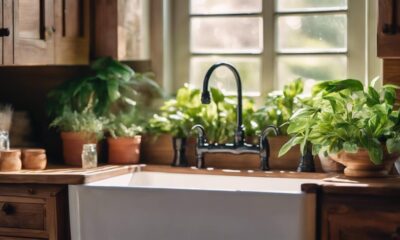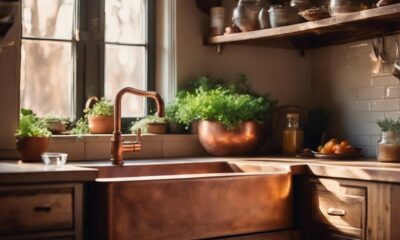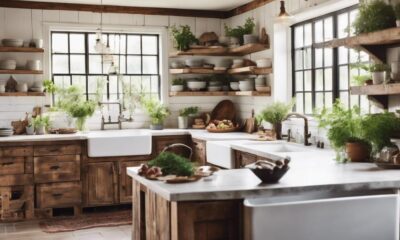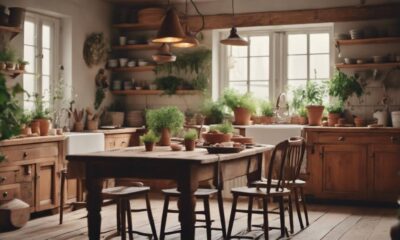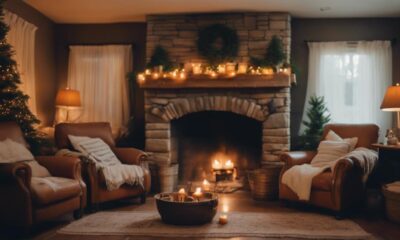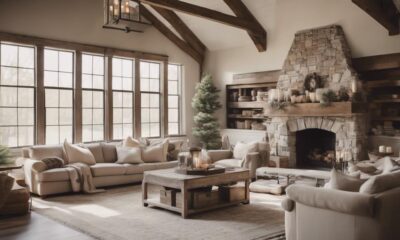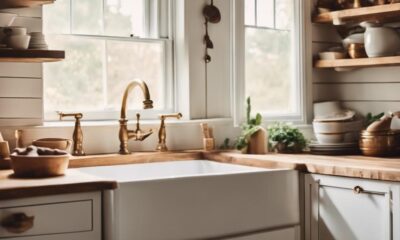Lifestyle
Creating a Home Office That Boosts Productivity and Well-being
Transform your space with tips for creating a home office that elevates productivity and well-being. Find your work-from-home bliss!
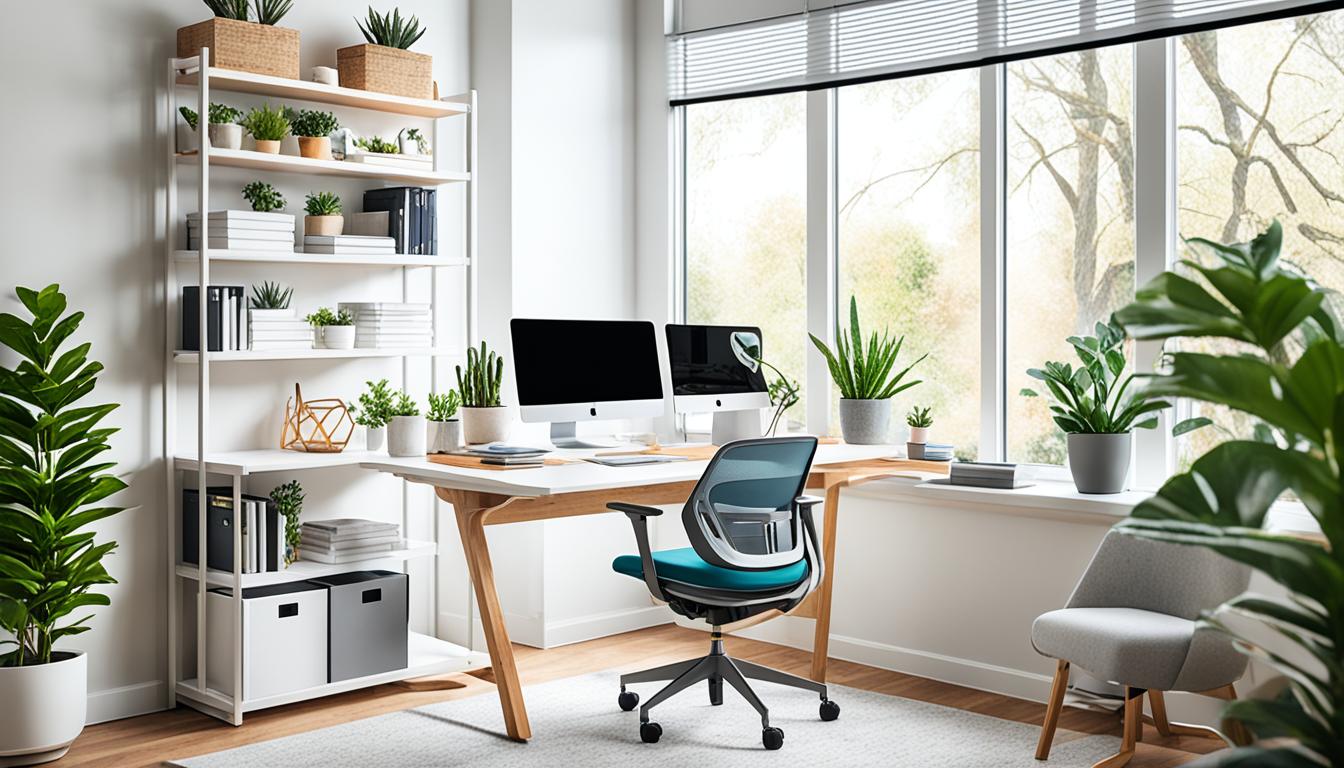
As the workplace evolves rapidly, more individuals are transforming their living spaces into home offices. Picture someone who previously commuted to work now telecommuting due to the pandemic. They have taken steps to enhance and create a more comfortable workspace.
They made big changes: a new ergonomic chair, a bigger desk, and organized cabinets. These changes made them 13% more productive and happier at work. This story shows how a good home office setup can really make a difference. It encourages others to create a space that boosts both creativity and work efficiency.
Key Takeaways
- The right home office setup can increase productivity by 13% or more.
- Ergonomic chairs prevent distractions and encourage better work habits.
- Natural light greatly enhances mental health and productivity.
- Quality lighting can reduce eye strain and improve work focus.
- Organized workspaces contribute to enhanced creativity and efficiency.
- Incorporating plants into the workspace can stimulate innovation.
- Using reliable technology and tools is crucial for long-term remote work success.
The Importance of a Productive Home Office
Creating a productive home office is vital for remote workers. Currently, 55% of workers choose a hybrid work model, craving more flexibility. This trend stresses the productivity importance of having a dedicated workspace. It helps improve focus and efficiency.
About 80% of company leaders now see that their teams will work remotely at least one day weekly post-pandemic. This shift makes it crucial to make home offices better for mental health and job happiness.
An effective workspace means fewer distractions. Multi-use areas usually bring challenges, lowering focus. Picking a spot just for work helps increase productivity.
Ergonomics also matter in a home office. Choosing the right furniture, like adjustable chairs and desks, helps avoid pains. Research shows that ergonomic setups boost productivity and wellness.
Natural light is key for productivity too. It’s proven that daylight improves mood, reduces eye strain, and keeps you alert. A bright, inviting workspace leads to better work and satisfaction. With the right setup, your home office supports both your job and your well-being.
Understanding Your Work Environment
Optimizing a home office means understanding its unique challenges. Identifying distractions is the first step to increasing productivity. Nosie, chores, or TV can interrupt your work.
Recognizing these helps you set boundaries. This is key to creating an effective office space at home.
Identifying Distractions at Home
Addressing these challenges needs open talk with family or roommates. Noise from them or pets can break focus. Noise-cancelling headphones can help reduce this noise.
Setting a work schedule and sharing it with others helps. This makes your work time respected.
Creating a Workspace Setup
Where you work really affects your productivity. Choosing a quiet spot away from daily life reduces interruptions. Your workspace should be comfy, with furniture that supports your posture.
Make sure things you use a lot are easy to reach. Adding things like art or plants can make the space nicer. Studies show plants in the workspace can make you react 12% faster.
Creating a Home Office That Boosts Productivity and Well-being
A great home office boosts work and comfort. Having a good workspace can make you 30% more productive and more creative. Also, using ergonomic furniture reduces health issues by 40%, which is key for comfort at work.
Natural light is very important in a home office. It can lessen eyestrain by 60%, letting you work longer without discomfort. Also, keeping your space tidy helps with creativity and efficiency. Less clutter means fewer distractions.
Personalizing your office boosts creativity by up to 25%. Adding things like vision boards or motivational quotes can make a big difference. Spaces that feel personal inspire more innovation than plain ones.
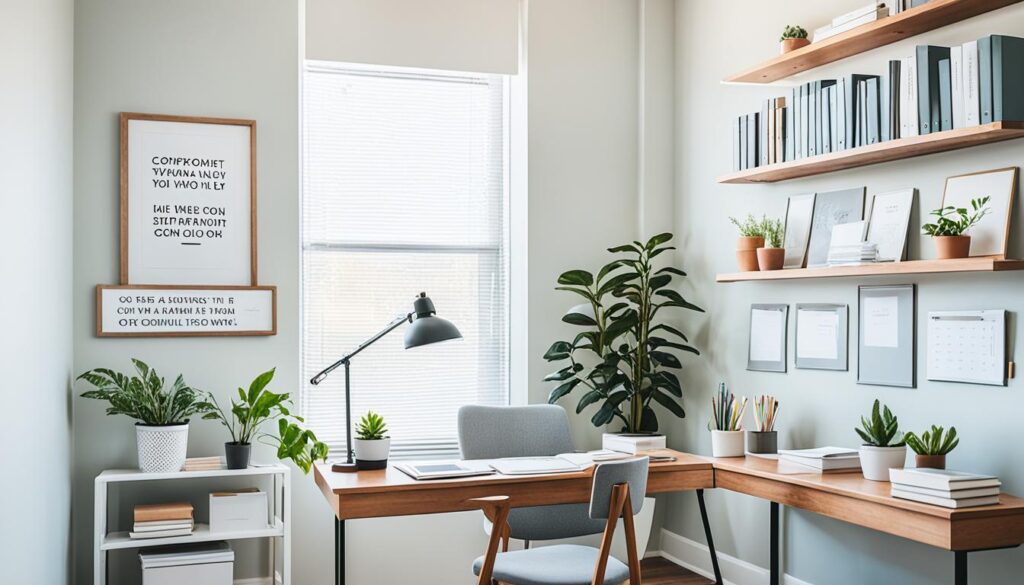
Good lighting and flexible work hours also help a lot. They can improve your focus and keep you less tired. Plus, having separate spaces can help you concentrate better than in open-concept areas.
In short, creating the right home office is very important. You need a place that looks good and works well. This way, you can be more productive and feel better while working.
Ergonomics: The Key to Comfort
Making your workspace ergonomic is key to feeling comfy and being more productive. The shift to working from home has made us see how important ergonomics is. By trying to reduce how much we strain ourselves, many have learned how valuable good office furniture can be.
Choosing an Ergonomic Chair and Desk
An ergonomic chair is important for keeping your posture right and reducing discomfort during long hours of work. Buying high-quality chairs like the Paxton, Hull, or Webb can really make a difference. These chairs support your lower back and can be adjusted to fit what you like. Desk ergonomics is also important. A desk that lets you sit or stand, like the Lopp or Wolfe Smart, helps you move and not get sore.
Proper Monitor and Keyboard Placement
Where your monitor and keyboard sit is crucial for a good workstation. Your monitor should be at eye level to avoid neck pain and be easy on your eyes. It should be about an arm’s length away, so you can sit comfortably. Your keyboard should be positioned in a way that keeps your shoulders relaxed. Your wrists should be straight and hands slightly lower than your elbows. Making these changes can really help you stay comfy and work better when you’re on the computer for a long time.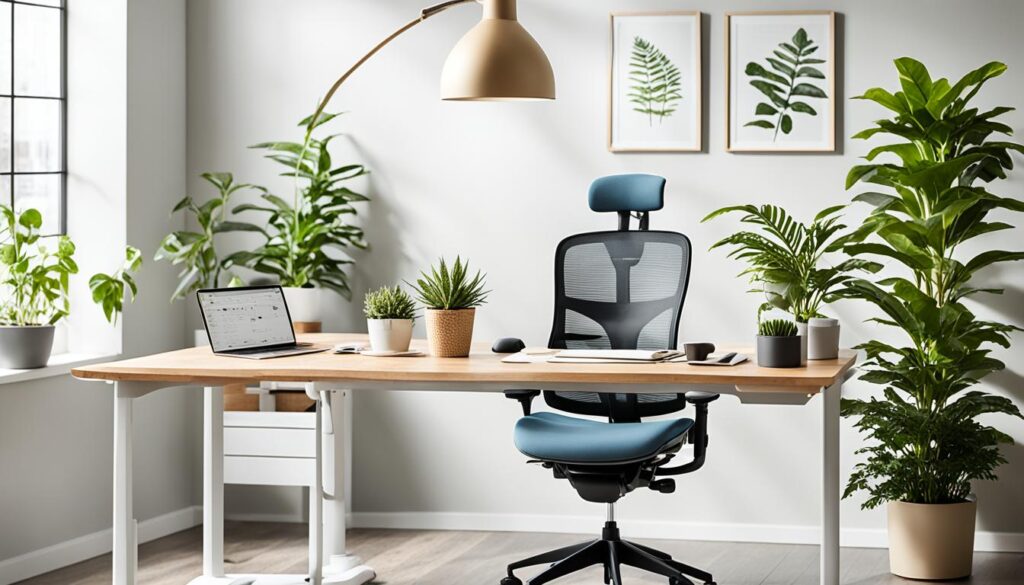
| Furniture Type | Key Features | Benefits |
|---|---|---|
| Ergonomic Chair | Adjustable height, lumbar support, comfortable cushioning | Improved posture, reduced strain, increased comfort |
| Sit-Stand Desk | Height-adjustable, stable surface, ample space | Reduces physical strain, boosts energy levels, enhances focus |
| Monitor Stand | Adjustable height, stable design | Maintains eye level, reduces neck strain |
| Ergonomic Keyboard | Split design, wrist support, adjustable angle | Promotes relaxed shoulder position, reduces wrist strain |
Lighting: Setting the Right Mood
Effective lighting is key in a home office. It shapes productivity and well-being. Using natural light is vital. It greatly improves the work space. The right lighting fixtures add to this, balancing comfort and energy efficiency.
The Benefits of Natural Light
Natural light boosts any workspace. It improves mood, focus, and productivity. Sunlight regulates melatonin, enhancing energy and focus. Place desks by windows for more sunlight. Taking breaks outside also helps with fresh air and sun.
Using Ambient and Task Lighting
Ambient and task lighting are important too. Ambient lighting sets the mood. Task lighting focuses light on specific areas, like desks. Mixing both types is best for a good workspace. Examples include:
- LED desk lamps like the AERTIA CERAMIC Table Lamp. They give bright light and save electricity by 89%.
- Dimmable ANON LED Light Bulbs. They add beauty and save energy.
- Smart lighting systems for control with apps or voice. They offer convenience and save power.
Putting these lights in the right spots reduces glare and shadows. It also prevents eye strain from screens. Plus, adjusting lighting for the workspace size and work type makes an atmosphere that helps work feel better.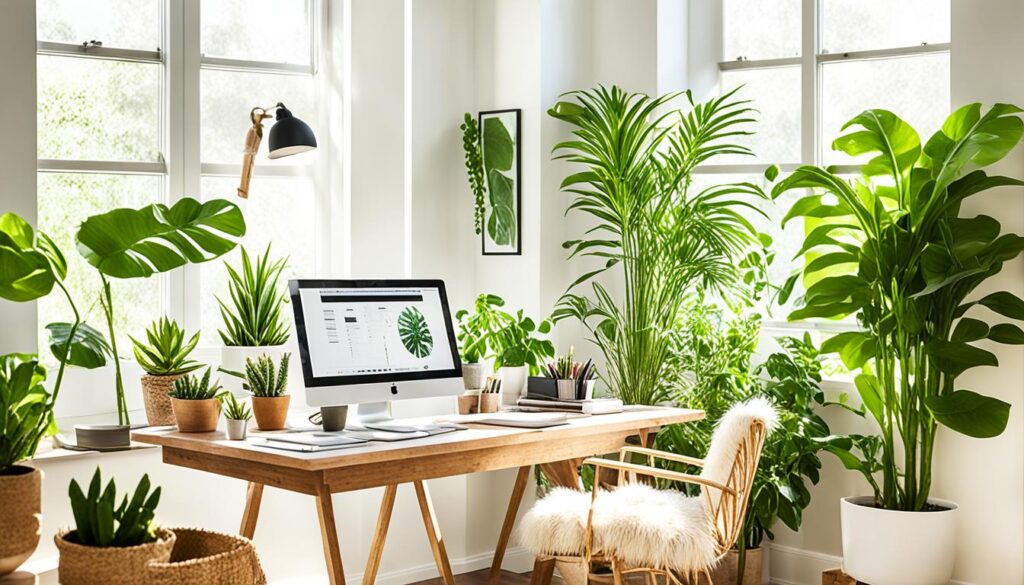
| Lighting Type | Features | Benefits |
|---|---|---|
| Natural Light | Direct sunlight from windows | Boosts mood, enhances focus, regulates circadian rhythms |
| Ambient Lighting | Overhead lighting, ceiling fixtures | Sets the mood, provides overall illumination |
| Task Lighting | Desk lamps, adjustable LED lights | Highlights specific work areas, reduces eye strain |
Mixing lighting types improves home office lighting. It makes working from home more comfortable and productive.
Investing in Quality Technology
Remote work has changed how we set up our home offices. Quality tech is key for a productive space. It includes reliable computers, stable internet, and good webcams for online meetings.
Adding productivity tools boosts your work experience too. For example, an extra monitor helps with multitasking. An ergonomic keyboard eases typing strain, and noise-cancelling headphones block out distractions.
Don’t forget about comfy furniture. A chair with good lumbar support can prevent back pain. This, combined with the right tech, keeps you productive all day.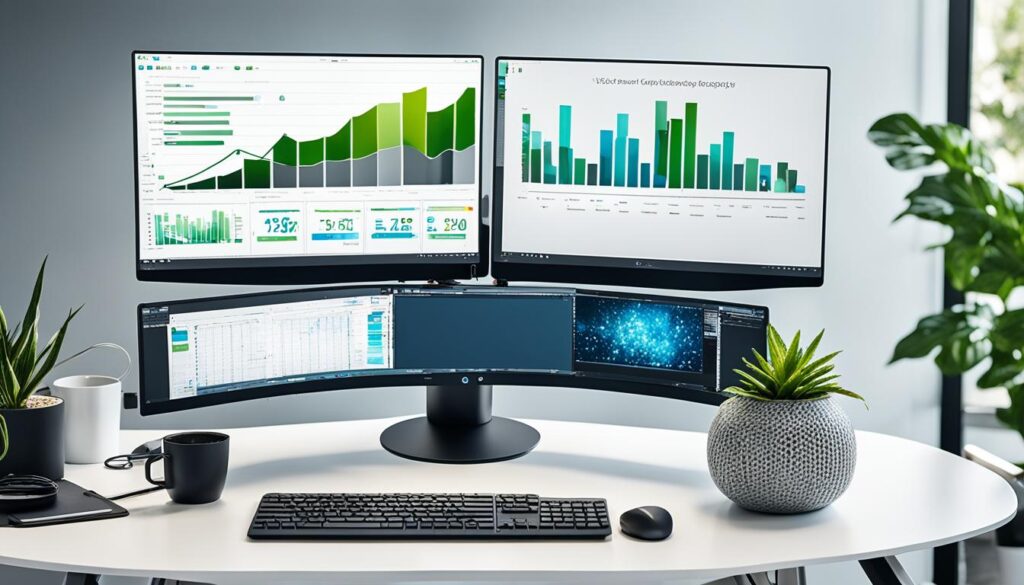
Minimizing Distractions in Your Home Office
A well-organized workspace boosts productivity in a home office. It’s key to have effective organization strategies. Decluttering helps by removing distractions that hurt focus, keeping your mind clear.
Organizing Your Workspace
Using things like file cabinets and desktop organizers makes a big difference. They ensure everything has its place, saving you time. A neat workspace also feels more professional and ready for work.
Using Noise-Cancelling Headphones
Noise can make it hard to concentrate, especially in busy places. Quality noise-cancelling headphones help. They’re great for clear audio in meetings and for creating a focused environment. This makes them a must-have for boosting productivity.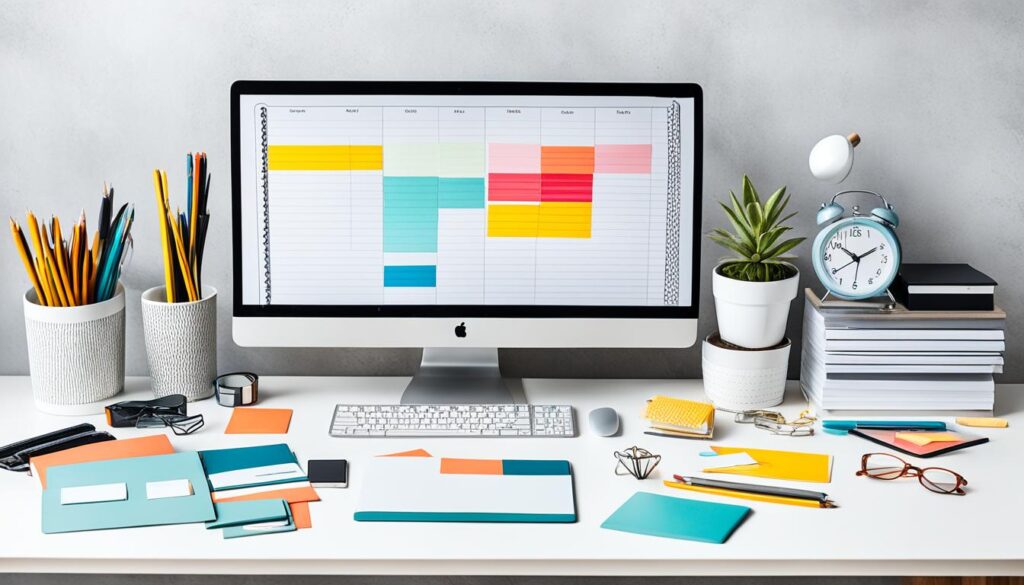
Personalizing Your Office Space
Creating a personal office space boosts motivation and enhances well-being. Adding decor and personal touches makes the space more appealing and creates a connection. Simple changes can make your workspace inspiring, increasing productivity and improving mood.
Incorporating Personal Touches
Adding personal items to your office can make it reflect your personality. Photos, artwork, and quotes can make you feel good and energize the space. Studies show that custom workspaces can make you 36% more productive, proving the value of personal touches.
Decor Ideas to Inspire You
Colors are key in setting the vibe of your office. Blue hues bring calm and focus. Yellow inspires creativity, and green is soothing and good for your eyes. Plants add a touch of nature, cut stress by 15%, and make the air healthier. Designing different areas for specific tasks can also help you concentrate better. A cozy corner for reading with comfy seats and nice light can boost happiness by 46%. Special stationery and supplies can increase your satisfaction by 27%. Here’s a quick look at some decor ideas:
| Decor Element | Benefit |
|---|---|
| Personal Photos | Enhances emotional connection |
| Artwork | Boosts creativity and mood |
| Vision Boards | Increases goal achievement by 50% |
| Plants | Improves air quality and reduces stress |
| Comfortable Seating | Boosts morale and encourages breaks |

With careful thought, you can turn your home office into a space that sparks creativity and boosts productivity and well-being.
Maintaining Work-Life Balance
Finding the right work-life balance is tough, more so with remote work’s rise. About 60% of U.S. workers feel their work-life balance isn’t good enough. Working from home has made it hard to separate work from personal life, making it important to set boundaries.
Before the pandemic, around 20% of people worked remotely. This number jumped to almost 70% during the pandemic. Homes turned into spaces for work, school, play, and exercise. It’s hard to tell work from free time, leading to burnout. Overworking can make you less motivated and productive, trapping you in a difficult cycle.
Starting small habits, like organizing tasks or using time management strategies such as the Pomodoro Technique, helps. It’s also crucial to set achievable goals to keep up motivation. Taking regular breaks is important for staying productive all day.
Setting clear work and personal time boundaries increases focus and creativity. Task delegation helps lessen stress and prevents burnout. Studies show that having a dedicated work area boosts productivity and happiness at work.
To sum up, here are some key ways to keep a good work-life balance with remote work:
| Practice | Description |
|---|---|
| Set Work Hours | Define clear start and end times for your workday to create separation. |
| Taking Breaks | Implement regular intervals for rest to maintain focus and energy levels. |
| Designate a Workspace | Create a specific area for work to mentally transition between home and work modes. |
| Prioritize Tasks | Identify and tackle essential tasks first, minimizing feelings of overwhelm. |
| Use Technology Wisely | Employ tools that help streamline tasks while avoiding distractions. |
| Delegate Responsibilities | Share workloads with team members to lighten personal stress. |
| Regular Check-Ins | Meet with colleagues to reflect on workloads and provide support. |
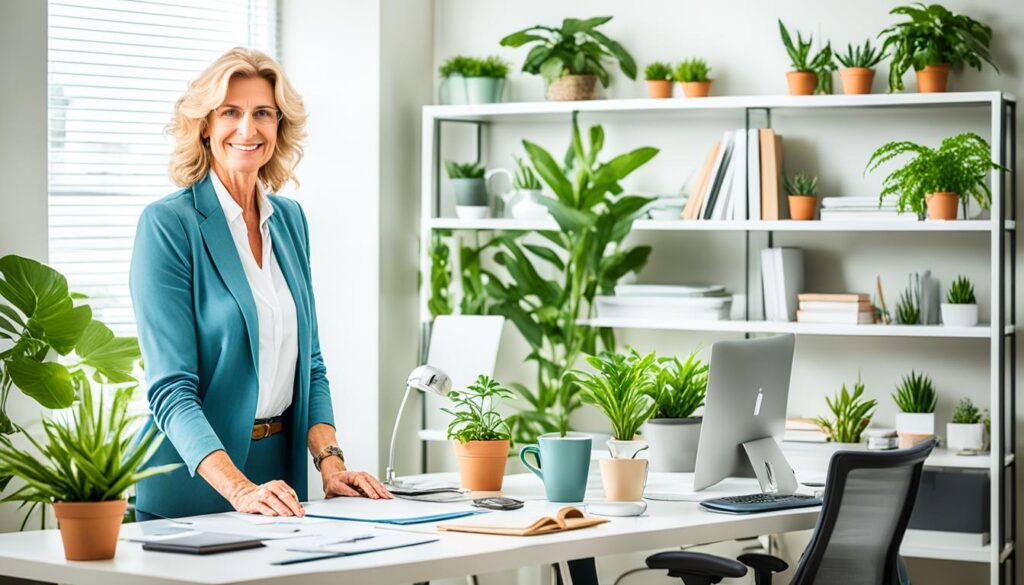
Adding Elements of Nature
Bringing nature into home offices can make them calm and efficient places. Most people living in cities stay indoors for up to 90% of their day. So, having indoor plants is crucial for a better work area. Studies show plants can make the air cleaner, which is important for feeling fresh.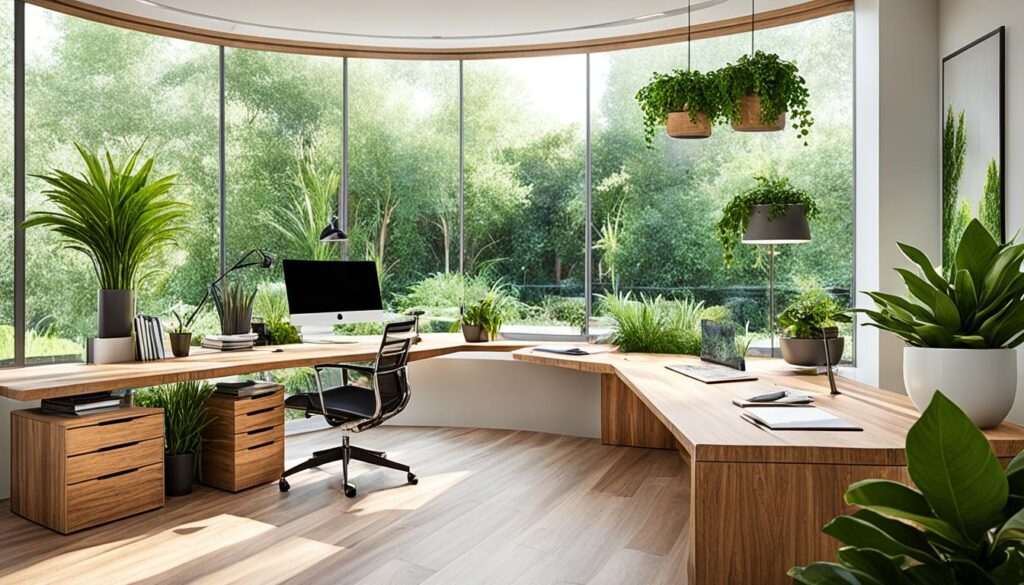
Indoor plants do more than just make a space look good. They can help improve memory by 20%. Adding greenery helps reduce stress and anxiety by 37%, depression by 58%, and anger by 44%. Research proves that people in offices with plants think 26% better. They also get sick less, cutting down absence by 30%.
Natural light is something 44% of employees want more of in their work area. It boosts mood and energy, making people feel better. Some plants like the Snake, Spider, and Peace Lily clean the air and don’t need much care. They are great for office spaces.
- Indoor plants contribute to a lively atmosphere.
- Natural materials like wood and bamboo create warmth and connection to the outdoors.
- Employees report lower stress levels and enhanced creativity in plant-filled spaces.
Connecting with nature in home offices leads to a healthy, welcoming, and efficient workspace. The beauty of nature, along with its benefits for health and work, shows its importance in today’s offices.
Smart Storage Solutions for Your Home Office
Having an organized workspace at home is vital. Smart storage solutions keep your office efficient and free from clutter. They also use vertical space well. This helps make your office organized while keeping it welcoming.
Utilizing Vertical Space
Vertical storage boosts space use in your office. Here are some ideas:
- Install shelves above desks to store books, files, and decorative elements.
- Use wall-mounted organizers for easy access to office supplies like pens and notepads.
- Utilize high shelves to keep rarely used items out of sight.
These ideas help you keep organized and also make space for creativity and comfort. Getting rid of old papers regularly also helps keep storage neat.
Essential Office Supplies to Keep Organized
The right office supplies improve efficiency. Keeping stock ensures you always have necessary items. Here are key supplies for an organized office:
| Essential Supplies | Purpose |
|---|---|
| Notebooks | For taking notes and tracking tasks. |
| Sticky Notes | For reminders and quick reference. |
| Pens and Markers | Essential for writing and highlighting information. |
| File Folders | Keeps documents categorized and easily accessible. |
Sorting your office supplies boosts productivity and streamlines your work area. Setting aside four hours to organize can offer long-term focus benefits.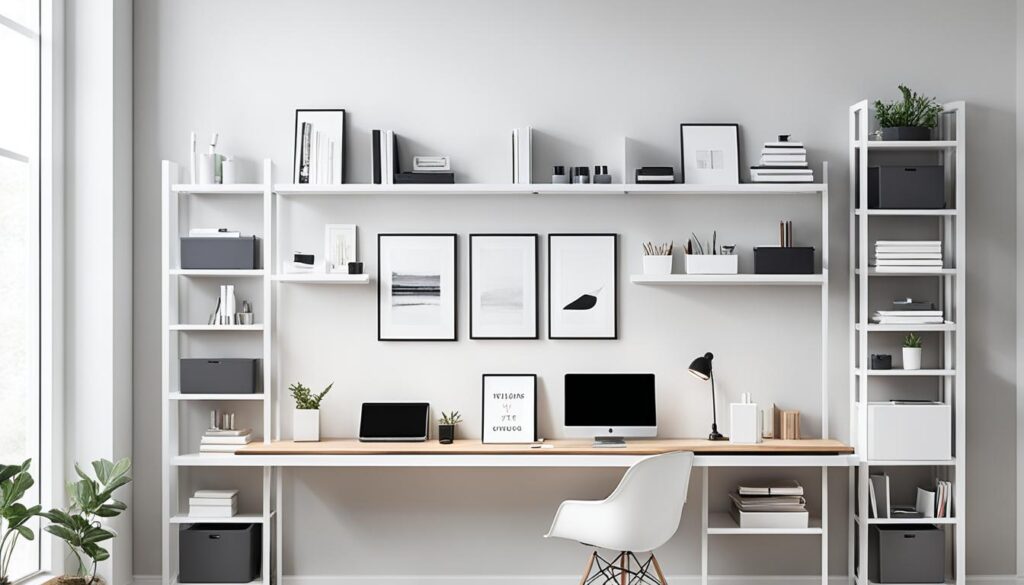
Conclusion
Creating an effective home office is crucial for productivity and well-being. Ergonomic furniture, natural light, and a clean space are key. These factors help increase focus, reduce pain, and make a positive work environment.
Setting work hours and using tools to manage tasks help too. Good air quality and taking breaks are important for your mind and body. Adding plants can boost your mood and health. Making these changes can create a home office that improves work and happiness.
As more people work from home, the design of a home office matters a lot. It affects how well we work and feel. Focusing on a supportive space is essential for success in work and life.
FAQ
How can I create a productive home office environment?
What role does natural light play in my home office?
Why is ergonomics important in a home office?
How can I reduce distractions in my home office?
What technology should I invest in for my home office?
How can I personalize my home office space?
How can I maintain a work-life balance while working from home?
What are some smart storage solutions for my home office?
Lifestyle
The Psychology of Color: Choosing the Right Palette for Your Home
Uncover how The Psychology of Color can guide you in selecting the perfect color palette to create your dream ambiance at home.
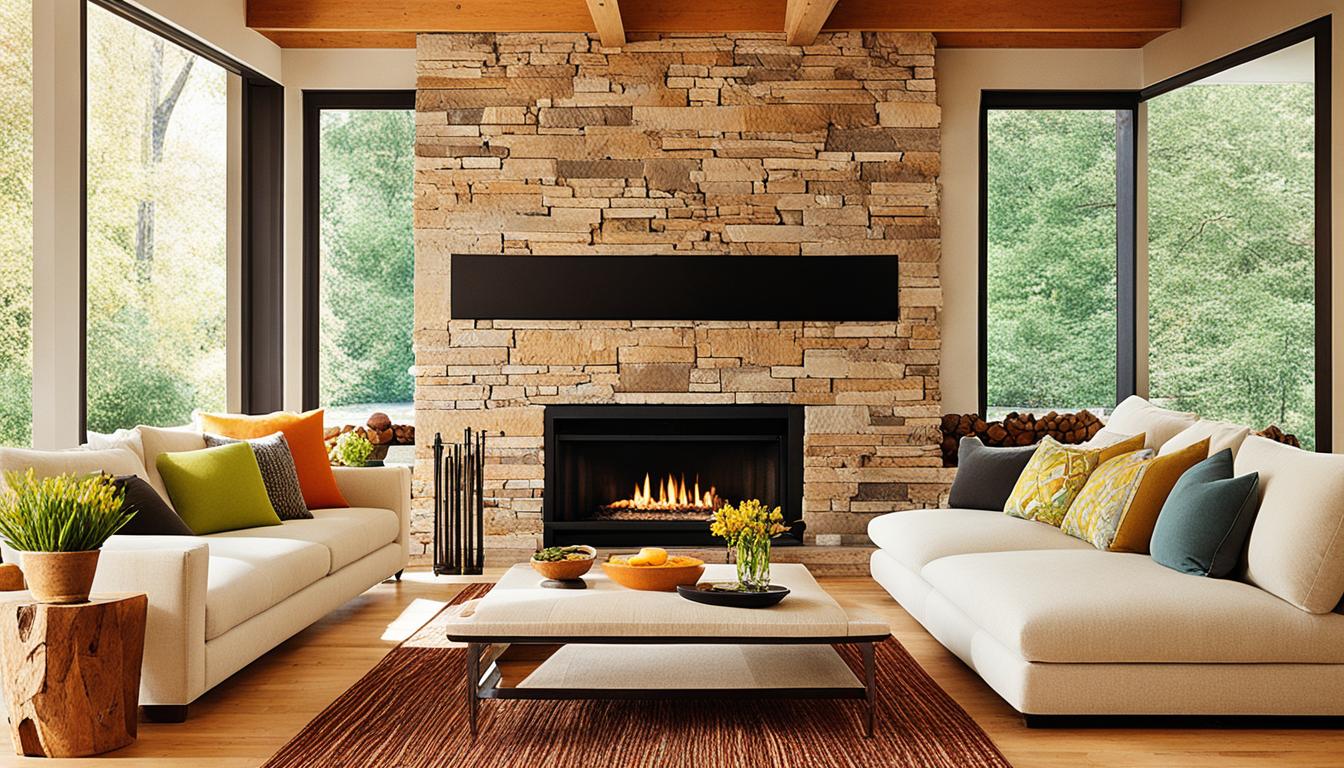
When Sarah moved into her new apartment, she found it overwhelming to choose wall colors. With so many options available, she felt unsure of where to begin. However, one evening at a home decor store, everything changed. Sarah observed how specific colors evoked different emotions within her. Cool blues brought a sense of calm, while vibrant reds energized her. This encounter ignited Sarah’s curiosity in the psychology of color.
It’s not just about looks; it’s about how colors make us feel. She realized the importance of colors in interior design. With this new understanding, Sarah wanted to pick the perfect colors for her home. She aimed to blend her style with the psychological impacts of her choices. Now, she was ready to turn her apartment into a personalized sanctuary.
Key Takeaways
- The psychology of color plays a significant role in interior design.
- Understanding color associations helps create the desired ambiance in homes.
- Different colors evoke specific emotions, guiding effective color palette selection.
- Timeless and trendy colors each have their place in creating a balanced home environment.
- The right color choices can enhance mood and promote well-being in various spaces.
Understanding Color Theory in Interior Design
Color theory is key for picking the right shades in decorating. It helps us understand how colors work together. This knowledge lets people create spaces that feel just right. The basics of color theory cover primary, secondary, and combinations for perfect harmony.
What is Color Theory?
Color theory starts with three main colors: red, yellow, and blue. Mixing these makes secondary colors like green, orange, and purple. Adding primary to secondary colors gives us even more options. This organized method guides designers in selecting colors. It’s a map for making spaces look and feel united.
Importance of Color Relationships
Knowing how colors relate is crucial for designing engaging interiors. Different color schemes, like complementary or analogous, create unique looks. Complementary colors offer a bold contrast, perfect for lively areas. Analogous colors, however, make a place feel calm and together. These principles help in balancing a room’s feel, impacting mood and comfort.
| Color Type | Examples | Effect on Mood |
|---|---|---|
| Primary Colors | Red, Yellow, Blue | Foundational, Vibrant |
| Secondary Colors | Green, Orange, Purple | Dynamic, Eye-Catching |
| Tertiary Colors | Red-Orange, Yellow-Green | Complex, Diverse |
| Warm Colors | Reds, Oranges, Yellows | Cozy, Inviting |
| Cool Colors | Greens, Blues, Purples | Calming, Refreshing |
Color theory is crucial in designing inviting homes. It guides us in making choices that bring together colors beautifully. This ensures our spaces are welcoming and balanced.
The Emotional Impact of Colors
Colors in interior design are powerful. They shape how we feel in our homes. By understanding color psychology, homeowners can create the atmosphere they desire. This comes from knowing how certain colors affect our mood.
How Colors Influence Mood
Colors touch our emotions differently. For example, red sparks energy and excitement. It makes your heart beat faster. Orange and yellow, on the other hand, make us feel more lively. Orange boosts our appetite and energy. Yellow lifts our spirits and helps us communicate better.
Pastel colors, like pink, calm us down and lessen aggression. Green brings a peaceful feeling, slowing down our heart rate. Then there’s blue. Blue makes us feel calm, lowers our blood pressure, and helps us sleep better. It’s perfect for a bedroom.
Purple increases our sensory awareness. Brown can make us feel relaxed. However, gray might make some people feel gloomy, and too much white might be overwhelming. Darker colors like black can make us look inward but sometimes feel a bit low. These effects show how important color choices are for our home’s emotional tone.
Common Color Associations
This table shows different colors and their emotional impacts:
| Color | Emotional Impact |
|---|---|
| Red | Energy and excitement; increases heart rate. |
| Orange | Boosts appetite and energy. |
| Yellow | Enhances communication and memory. |
| Pink | Promotes calmness and reduces aggression. |
| Green | Encourages tranquility and energy preservation. |
| Blue | Induces relaxation and lowers blood pressure. |
| Purple | Enhances sensory awareness. |
| Brown | Creates a sense of relaxation. |
| Gray | Dampens mood and energy. |
| White | Bright and focused but can feel uncomfortable. |
| Black | Introspection but may lead to depressed moods. |
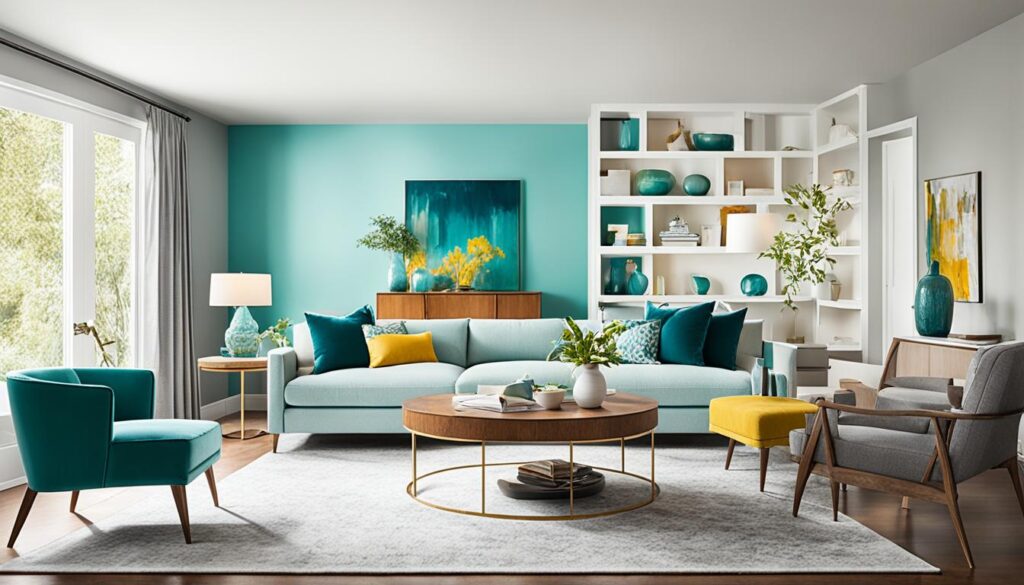
Exploring the Psychology of Color: Choosing the Right Palette for Your Home
When you pick colors for your home, it’s not just about looks. It’s also about how colors make us feel. For example, blue brings calm and is great for bedrooms and bathrooms. It helps us relax. Green brings peace and health, perfect for living rooms or home offices.
Yellow means happiness and works well in kitchens or dining areas, where people hang out together. Red adds energy and is good for dining spots, making them lively. Purple stands for luxury and sparks creativity, suited for living areas or offices. And orange is all about fun, awesome for gyms or playrooms.
Neutrals are flexible, adding elegance without taking over. A good room mixes colors well: complementary colors for excitement, similar ones for harmony, and triadic schemes for balance. What you choose should show off your style and how you live.
Knowing how color affects mood is key to making rooms that feel good. A main color brings everything together. Trying out paint samples helps pick the best colors that match your taste and the room’s vibe.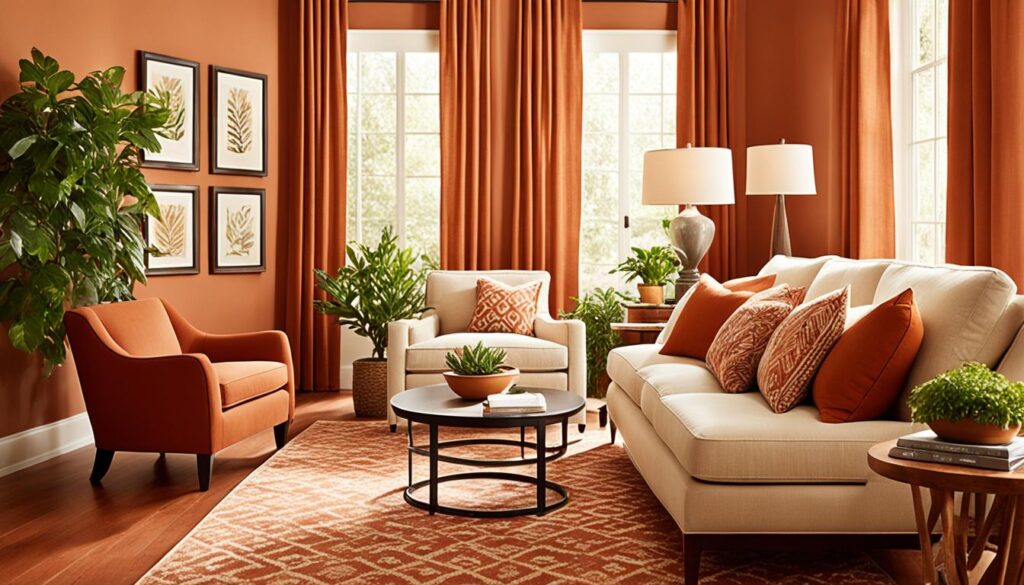
| Color | Associated Emotion | Ideal Rooms |
|---|---|---|
| Blue | Calmness | Bedrooms, Bathrooms |
| Green | Tranquility | Living Rooms, Studies |
| Yellow | Happiness | Kitchens, Dining Rooms |
| Red | Passion | Dining Areas, Accent Colors |
| Purple | Luxury | Living Spaces, Offices |
| Orange | Energy | Exercise Rooms, Play Areas |
| Neutral Tones | Flexibility | Any Room |
The Role of Colors in Different Rooms
Colors play a crucial role in setting a room’s mood. Each room has a unique purpose, and the right colors can enhance that. Knowing how to pick colors for bedrooms, kitchens, and living rooms helps create the right environment for activities and feelings.
Bedrooms: Creating Calm Spaces
Bedrooms are places for rest and peace. Soft blues, greens, and gentle purples work well here. These colors bring tranquility, perfect for peaceful sleep and relaxation. Also, choosing colors that you personally like can make the space more comforting.
Kitchens: Energizing Ambiance
The kitchen is where the heart of a home beats, full of life and gatherings. Bright, warm colors like yellows, oranges, and reds bring energy and encourage people to socialize. These shades make the mood better and the space welcoming. Following the 60-30-10 rule—a dominant warm color, a complementary secondary color, and an accent—makes the kitchen both lively and harmonious.
Living Rooms: Balancing Relaxation and Socialization
Living rooms are for chilling and hanging out with others. Using a mix of colors helps balance these activities. Combining soft neutrals with bold colors makes the room versatile. Warm shades mixed with calming ones offer a cozy spot for chats while also keeping a relaxed vibe.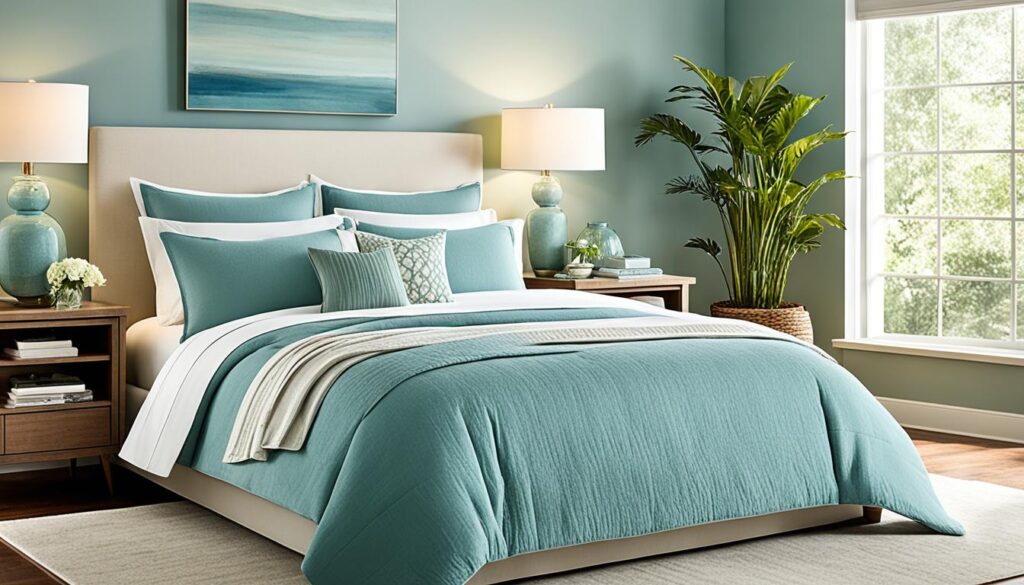
| Room | Color Type | Function |
|---|---|---|
| Bedrooms | Cool Colors | Create calm, restful spaces |
| Kitchens | Warm Colors | Enhance energy and social interaction |
| Living Rooms | Blended Colors | Balance relaxation and engagement |
The Color Wheel: A Guide to Harmonious Choices
The color wheel helps pick colors that work well together. It shows how colors interact, helping you create a beautiful space. It lets you make a palette that brings your room to life.
Monochromatic Schemes
Monochromatic schemes use one color in different shades and tints. They make a space feel calm and put together. Using variations of the same color, you can design a space that’s striking yet harmonious. These schemes are perfect for bedrooms or places for quiet time.
Complementary and Analogous Colors
Complementary colors are opposite each other on the wheel, like blue and orange. They add excitement and contrast to a space. These pairings are great for lively areas like living rooms. On the other hand, analogous colors are side by side, like blue and green. They bring a peaceful vibe, ideal for rooms meant for rest.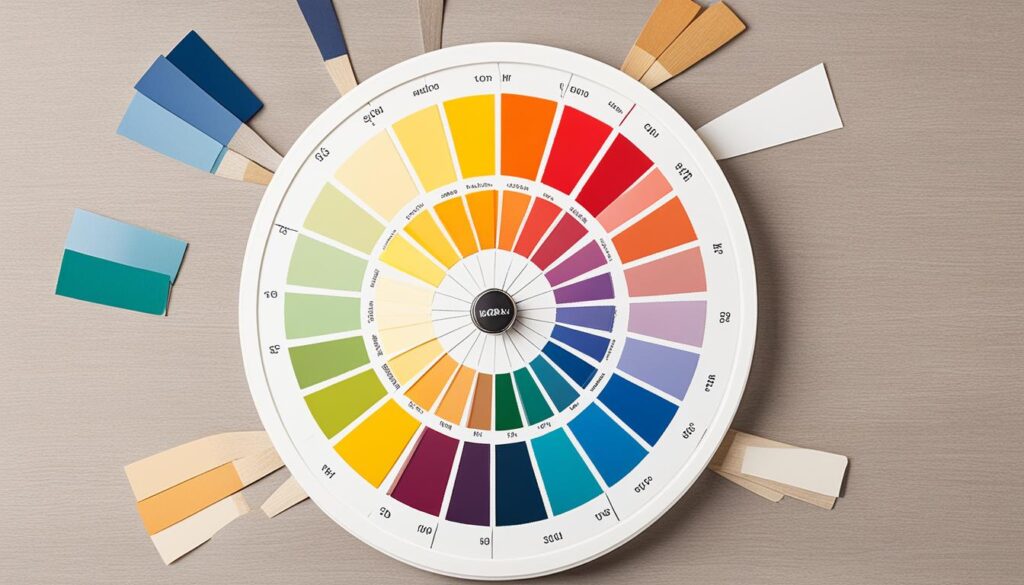
The Influence of Lighting on Color Perception
Lighting shapes how we see colors in a space. It’s vital to know the difference between natural and artificial light. This knowledge helps create the right mood in any room. The kind of light used can change how colors look. This affects the room’s overall look and feel.
Natural vs. Artificial Light
Natural light makes colors look brighter and more true to life. This makes rooms feel more welcoming. It’s great for living rooms or dining areas where warm colors like reds and yellows shine. These colors bring energy and warmth. Artificial light, though, can change how we see colors. Incandescent, fluorescent, or LED lights each have different effects on colors. So, choosing the right light is key for accurate color representation.
Testing Colors in Different Lighting Conditions
It’s important to test colors in various lighting to keep their charm all day. Look at colors under natural and artificial lights to find out more. For example, cool blues and greens might pop under warm evening lights. But they may look dull in daylight. Light pastels can create a calm atmosphere in natural light.
Deeper shades offer a touch of sophistication. Yet, they might be too bold in strong artificial light. Mixing warm and cool colors right can make a room perfect for rest, creativity, or work.
Balancing Bold and Neutral Colors
Creating a pleasing space means mixing bold and neutral colors well. Bold colors add life to a room without taking over. For example, a bright red or a sunny yellow can make fun highlights. These are set against neutral backgrounds. This approach makes the area look exciting but still welcoming.
Using Bold Colors as Accents
Bold colors can set the mood and inspire activities. For example:
- Red makes a place lively, great for living rooms or gyms.
- Yellow brings warmth and hunger, best for kitchens but not too much.
- Orange sparks creativity and energy, ideal for offices or where people hang out.
Creating Harmony with Neutrals
Neutrals are key in calming down the bold colors. They make a peaceful scene. Good neutral colors include:
- Soft whites and grays make places look clean, like in bathrooms.
- Warm neutrals are welcoming, perfect for living and dining spaces.
- Cool neutrals and bright accents help focus and work well in offices.
By smartly mixing bold with neutral colors, designers make places that are both energetic and calm. They meet different needs but keep everything looking good together.
| Color | Effect | Ideal Spaces |
|---|---|---|
| Red | Increases heart rate and activity | Living room, home gym |
| Blue | Calming, lowers blood pressure | Bedrooms, bathrooms |
| Yellow | Boosts appetite, warmth | Kitchens, dining areas |
| Green | Symbolizes balance and harmony | Home offices, bedrooms |
| Purple | Promotes calmness or sophistication | Bedrooms, living areas |
| Orange | Inspires enthusiasm and creativity | Social spaces, home offices |
Practical Considerations When Choosing Colors
Choosing paints is not just about looks. It’s about mixing practical factors that affect your room’s feel. Knowing about paint durability and how big the room is helps create a balanced and useful space.
Durability and Maintenance of Paints
When picking paints, think about how tough they are. Some paints are better for busy areas because they last longer. For kitchens and bathrooms, semi-gloss or satin finishes are good because they resist moisture and are easy to clean. How easy it is to maintain different paints affects how often you’ll need to touch up the walls. High-gloss paints look nice but might need more care than flat finishes. Flat finishes hide dings but aren’t as easy to scrub clean.
Size and Shape of the Room
The size of the room matters a lot when choosing colors. Light colors can make small rooms feel bigger and more welcoming. Dark colors can make large rooms cozy but use them carefully to avoid a cramped feeling. The room’s size and shape influence what colors will look best.
Rooms with lots of natural light can handle bold colors. But if a room doesn’t get much light, it’s better to use light, bright colors. These can make the room feel happier and more open.
Current Trends vs. Timeless Colors
Finding the right mix of trendy and timeless colors is key in interior design. Homeowners often pick colors that are both modern and classic. Knowing how to mix these can spark creativity and keep a room’s look together.
Finding a Balance
Color trends and classic palettes shape a home’s feel. The 90s loved sage green and pink beige, while the early 2000s favored espresso brown. Since 2016, black has been big in decor, thanks to new tech and its popularity online.
Timeless colors like soft gray, beige, and white form a strong base. They’re versatile and last long, perfect for a modern yet timeless space. Adding accents carefully creates a room that can evolve with the trends.
Incorporating Trends into a Classic Palette
Adding trendy colors to a classic look means being flexible with decorations. Bold colors like deep blues or rich burgundies bring elegance without overpowering. A simple black and white background lets vibrant or earthy colors pop.
According to color psychology, blues and greens make bedrooms peaceful, while yellows and oranges brighten up home offices. Starting with a neutral base helps homeowners change decorations easily. This approach keeps decor interesting and ensures it stays attractive over time.

Personalizing Your Home with Color
Choosing colors for your home lets you make spaces that show who you are. When you pick colors you love, every room turns into a place that means something special to you. Using colors with personal importance makes each space feel true to you and welcoming.
Reflecting Personal Style and Preferences
Your own style impacts your color choices a lot. Some people love calm blues and greens for quiet rooms. Others choose lively reds and yellows for areas like kitchens. Knowing the effect of colors on feelings can guide you in choosing wisely.
Vibrant oranges are great for fun rooms, while soft pastels make reading spots cozy. Including your favorite colors makes the whole house feel more like home.
Incorporating Meaningful Colors
Adding colors that mean something to you makes your home feel closer to your heart. Different colors make us feel different things—blue is calming, green feels fresh, and gray is classy. The 60-30-10 rule helps balance colors: 60% for the main color, 30% for secondary colors, and 10% for accents.
Try your colors in different lights to see the true effect. This ensures your home matches your lifestyle perfectly.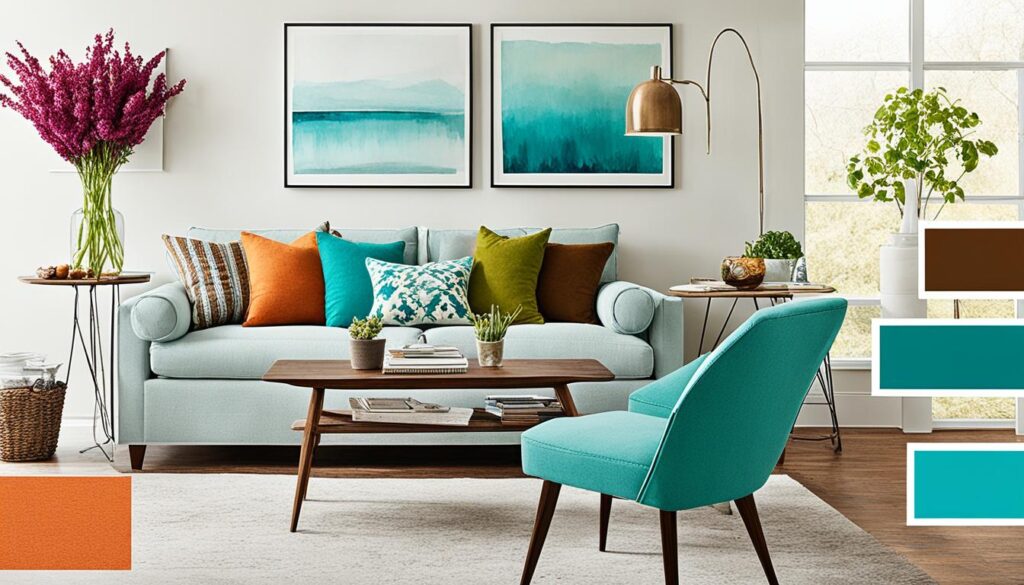
| Color | Emotion | Best for |
|---|---|---|
| Blue | Calming, serene | Bedrooms, bathrooms |
| Red | Energy, passion | Dining rooms |
| Green | Refreshing, tranquil | Living rooms |
| Yellow | Cheerfulness, warmth | Kitchens |
| Gray | Neutral, sophisticated | Any room |
| Purple | Royal, creative | Bedrooms, luxury spaces |
| Orange | Vibrancy | Playrooms, workout areas |
Impact of Color Choices on Space Perception
Understanding how different colors change the feel of a room is key to a welcoming home. Colors do more than just look pretty; they affect our emotions too. Light and dark hues play big roles in how big or small a room feels.
Using Light Colors to Create Space
Want your room to feel bigger and brighter? Use light colors like white, cream, or soft pastels. These colors make spaces feel open and inviting. If your room gets natural light, light colors can make it feel even more spacious.
Soft blues and greens add a calm vibe, making the room seem larger. To boost this effect, add mirrors. Mirrors reflect light, making the space look bigger.
Dark Colors for Intimacy
Prefer a cozy feel? Choose dark colors. Deep blues, grays, or greens can make a space feel snug and welcoming. Sure, dark colors might make a room feel smaller, but they add depth and elegance, especially as accent walls or in furniture pieces.
Using dark tones right means balancing them with light accents. This keeps the room cozy but not too tight.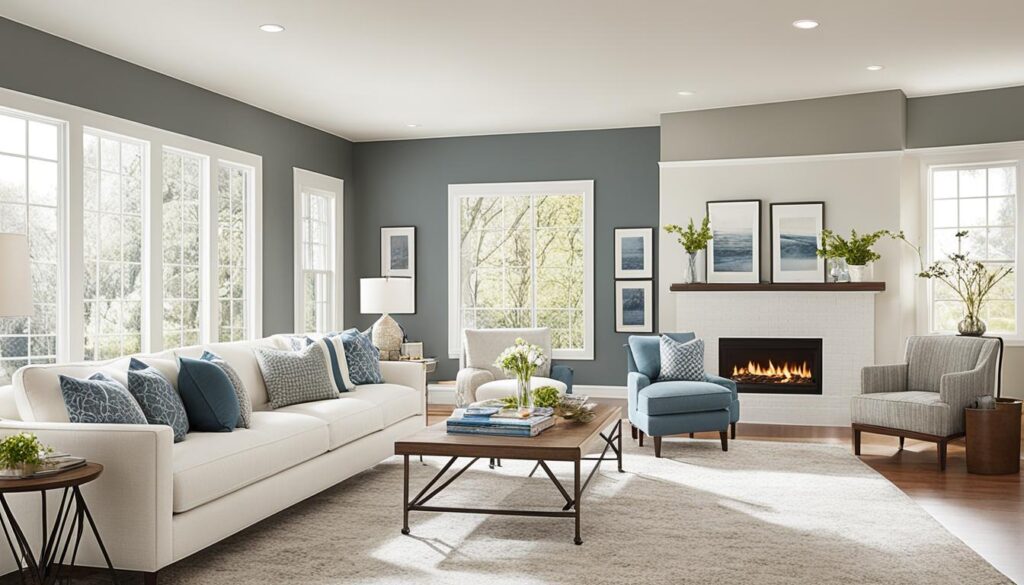
Picking the right colors can really change how a room feels. With these tips, you can make any space both comfy and stylish.
| Color Category | Effect on Space Perception | Recommended Uses |
|---|---|---|
| Light Colors | Make spaces feel larger and airier | Smaller rooms, ceilings, and sunlit areas |
| Dark Colors | Create coziness and warmth | Accent walls, living rooms, and bedrooms |
| Neutral Colors | Promote harmony and versatility | Any room; complements both light and dark tones |
| Cool Colors | Evokes feelings of tranquility | Relaxing spaces like bedrooms and bathrooms |
| Pastel Colors | Add a soft, airy quality to interiors | Children’s rooms, kitchens, and living areas |
Conclusion
Looking into color psychology, we find it plays a huge role in interior design. A careful choice of colors can shape how we feel in a room. It’s important to know how colors affect our mood and the space around us. For example, bright colors might bring energy to a kitchen, while cool shades can make a bedroom more relaxing.
By following color palette tips, we can see how different colors look at various times. Sunlight makes warm colors bright, but electric light changes how colors appear. Knowing this helps us choose the right colors for our homes. We can pick colors that fit our style and make each room work better.
In wrapping up, choosing colors wisely does more than make our homes look good. It changes how we feel in our living spaces. Using color psychology, our homes can become places of peace and comfort. They become beautiful spaces that also help us feel good.FAQ
What is color psychology in relation to interior design?
Why is understanding color theory important for home decor?
How do colors influence mood and ambiance in different spaces?
What are some color considerations for different rooms in the home?
How can a color wheel assist in selecting a color palette?
What effect does lighting have on color perception?
How can homeowners balance bold and neutral colors in their decor?
What practical factors should be considered when choosing paint colors?
How can homeowners maintain a balance between current color trends and timeless hues?
How can personal style be reflected through color choices in a home?
How do different colors affect perceived space in a room?
Lifestyle
Fitness at Home: Setting Up the Perfect Home Gym on Any Budget
Discover how to create your ideal home gym for any budget with our guide to Fitness at Home: Setting Up the Perfect Home Gym on Any Budget.
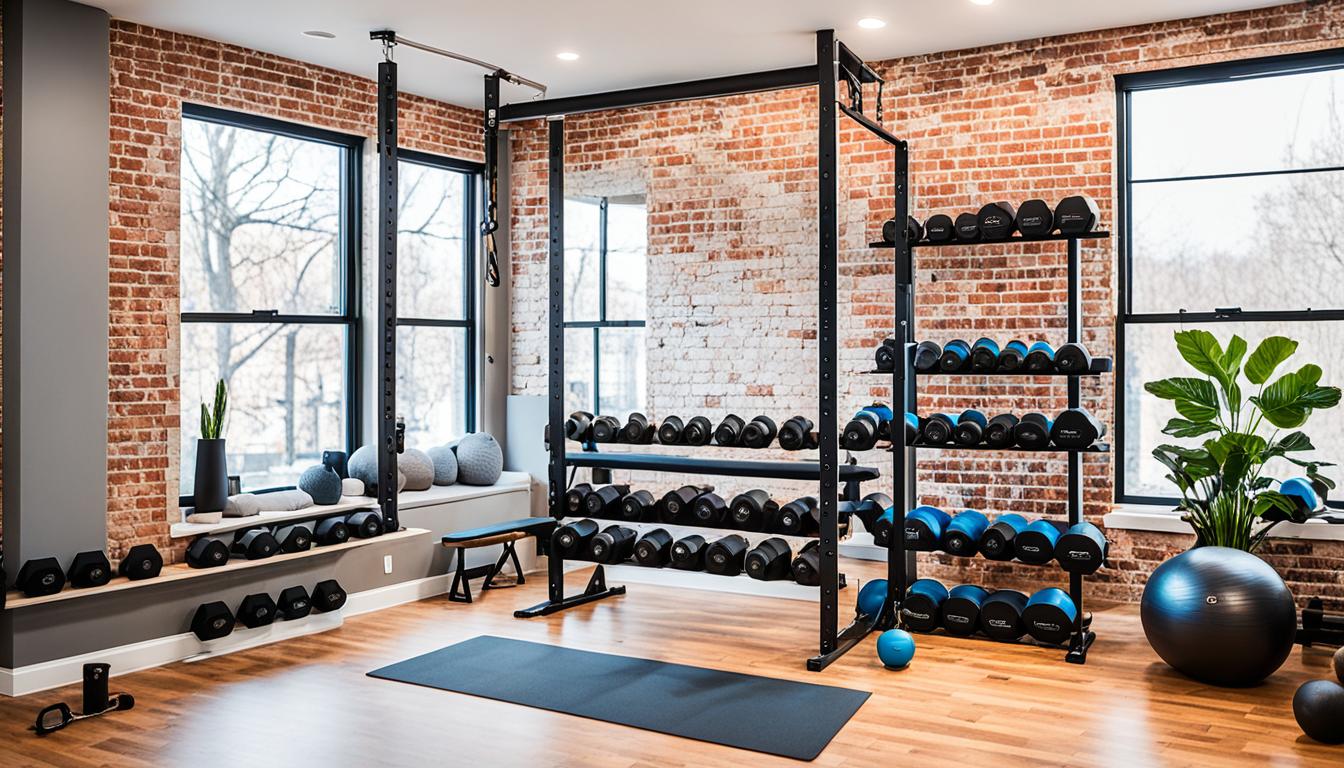
Sarah used to think workout routines were dull. However, the pandemic introduced her to a different approach: exercising at home. She converted a neglected corner of her living room into a personal gym. Using simple equipment and a limited budget, she scouted for discounts on fitness gear.
Sarah’s gym started with just a yoga mat and dumbbells. It grew to include resistance bands, a jump rope, and even plants for cheer. This move saved her money on gym fees. Plus, it made her love fitness, fitting her schedule and likes.
In this guide, you’ll get tips to make a home gym that meets your fitness dreams without costing a lot. No matter your budget or the room you have, setting up a home workout area is possible.
Key Takeaways
- Setting up a home gym can be done on any budget, catering to a wide range of fitness enthusiasts.
- Affordability is essential, utilizing simple storage solutions like metal shelving for gym equipment organization.
- Safety measures are vital for home gym setups, ensuring equipment stability and designed layouts for movement.
- Personalizing your fitness space with décor can enhance motivation and create an inspiring environment.
- Small, effective home exercise equipment can significantly impact workout routines without heavy financial investment.
- Proper planning of your workout space contributes to a more functional and stimulating exercise environment.
Benefits of Having a Home Gym
Building a home gym offers many benefits that change how you work out. It lets you make a fitness space that suits your schedule and needs. This flexibility isn’t found in public gyms.
One key benefit is convenience. There’s no need to travel, which saves time and lets you work out any time. People are more likely to exercise when it’s easy and fits their lifestyle. This has led to more people working out at home.
The cost is another major factor. Starting a home gym requires some money upfront. But, you’ll save on gym fees and travel costs over time. This means saving money while staying committed to staying fit. Plus, you can pick workouts that you enjoy the most.
Home gyms also offer a wide range of exercises. You can use dumbbells and kettlebells to work different muscle groups. Bodyweight exercises and resistance bands are great too. They offer varied workouts without needing a lot of equipment.
Starting with basic tools like stability balls can also target key areas. Slowly adding different equipment keeps workouts interesting and motivation high. This way, your fitness journey remains fun and effective.
In conclusion, the convenience and savings of home gyms attract many people. With the right setup, anyone can start their fitness journey at home. It’s a great way to stay fit and save money.
Essential Equipment for Your Home Gym
Building a home gym means choosing essential equipment wisely. People have different fitness goals, but some items are key for everyone. These items include weights for lifting and machines for cardio. Picking the right tools will make your fitness journey more effective.
Weights and Resistance Training
For a home gym, weights for home gym setups are essential. Adjustable dumbbells and kettlebells are great since they let you switch up the resistance. They are compact and versatile, making them a smart first buy. Resistance bands add variety to workouts. Loop and tube bands, especially with door mounts, are good choices.
Cardio Options
There are many cardio workout options to keep your heart healthy. Treadmills, spinning bikes, and rowing machines are top picks for endurance. Jump ropes are good for tight spaces and offer a solid cardio workout. It’s wise to get at least one good cardio machine to improve fitness.
Stretching and Recovery Tools
Recovery tools are a must-have in any fitness plan. Foam rollers and Theraguns help your muscles recover and improve flexibility. They reduce soreness and help with better movement after exercising. Adding these to your home gym makes your workout plan complete.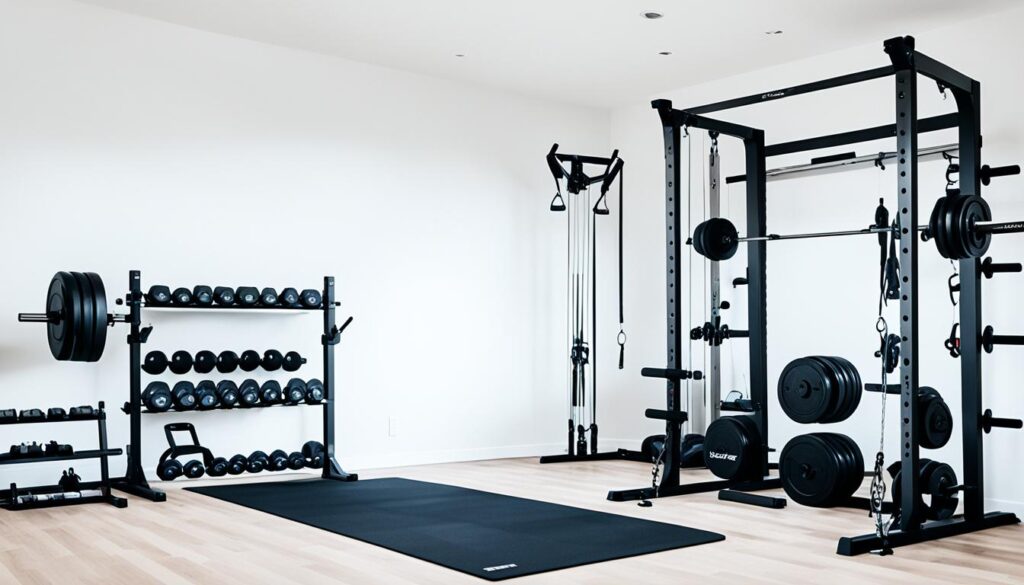
Budgeting for Your Home Gym Setup
Creating a budget for your home gym is an important first step. It determines how much you can spend without stress. A budget helps you focus your money on what you need based on your fitness goals and the costs of fitness equipment.
Determining Your Budget
Start by looking at your finances to set a spending limit. Costs range widely. Simple gear like resistance bands or yoga mats start at $20. But, full setups can go over $2000. Here’s a quick overview:
| Budget Category | Estimated Cost | Equipment Included |
|---|---|---|
| Low-Cost | Under $100 | Bodyweight exercises, resistance bands |
| Mid-Range | $200-$500 | Adjustable dumbbells, kettlebells, yoga gear |
| High-End | Over $1000 | Power racks, cardio machines (e.g., Peloton) |
Prioritizing Equipment Purchases
Once you have a budget, picking the right equipment is key. Start with basic items that offer a lot of value. Adjustable dumbbells, like those from NordicTrack or Bowflex, are a great choice. They’re versatile and offer a range of weights.
Also, consider the Fitness Reality 810XLT Super Max Power Cage for a good deal. Beginning with essential gear lets you manage your budget and still get a great workout.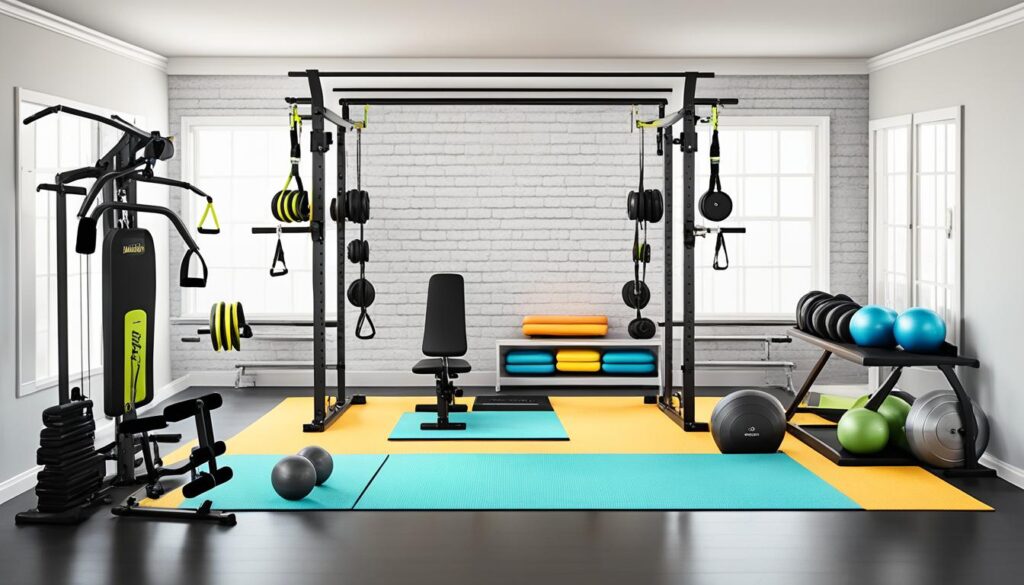
Fitness at Home: Setting Up the Perfect Home Gym on Any Budget
Creating your own gym space at home is rewarding. It’s perfect for those with limited space. With careful planning, one can set up effective workout areas that fit their lifestyle. A workout space in a room, basement, or corner can inspire your exercise routine. Picking the right equipment carefully helps you make the most of your workouts. This way, you won’t have to sacrifice space or accessibility.
Creating a Dedicated Workout Space
Having a special spot for fitness makes exercising a daily habit. Even small corners can become workout areas. Consider how Trisha Enriquez turned a small basement into a gym. Beginning with basic gear allows for slow additions, making fitness fun and simple. Setting up a workout space means you’ve always got a reason to exercise.
Choosing Space-Saving Equipment
Choosing the right tools for your home gym is key. Options that save space but are effective include:
- Adjustable dumbbells
- Kettlebells for versatile workouts
- Resistance bands for strength
- Jump ropes for heart health
These items let you exercise your whole body without cluttering the room. Adding a foldable bench or a compact pull-up bar can make your gym even better. These choices support many kinds of workouts and can grow with your fitness journey.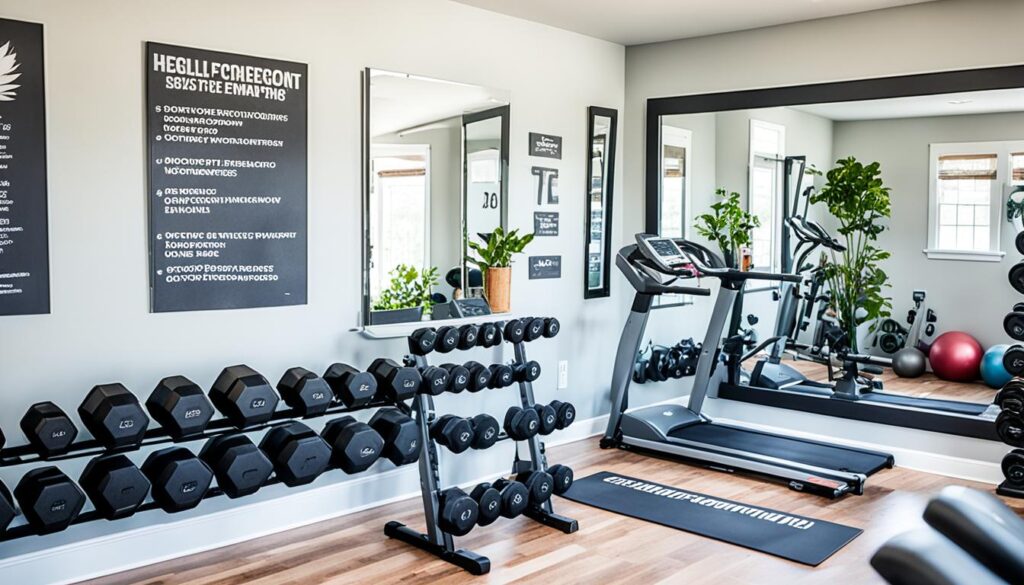
Starting a home gym is easy with the right approach. By picking versatile tools and using your space wisely, you can build a welcoming workout spot. Simple, adaptable equipment helps transform a small area into an inspiring place for health and fitness.
Buying Equipment Without Breaking the Bank
Setting up a home gym shouldn’t empty your wallet. Making wise choices helps get quality gear while saving money. Focus on fitness tools that do more than one thing. This way, you save both space and cash. For example, adjustable dumbbells replace multiple weights with one item, being both space-friendly and cost-effective.
Investing in Multi-Tasking Tools
Multifunctional fitness tools make workouts better without costing too much. The Titan Fitness T-2 Series Rack, for around $400, supports up to 2,200 lbs. It’s a strong base for any home gym. Add Iron Bull Strength Powder-Coated Kettlebells to your kit, ranging from 4 to 70 lbs. They’re tough, color-coded for quick selection, and built to last.
Buying Secondhand Gym Equipment
Looking for secondhand workout gear can save a lot of money. Sites like Facebook Marketplace have lightly used items at low prices. Always check the items well. A good find could be the Giant Lifting Adjustable Weight Bench. It’s light and adjusts to six positions, adding great value for less money.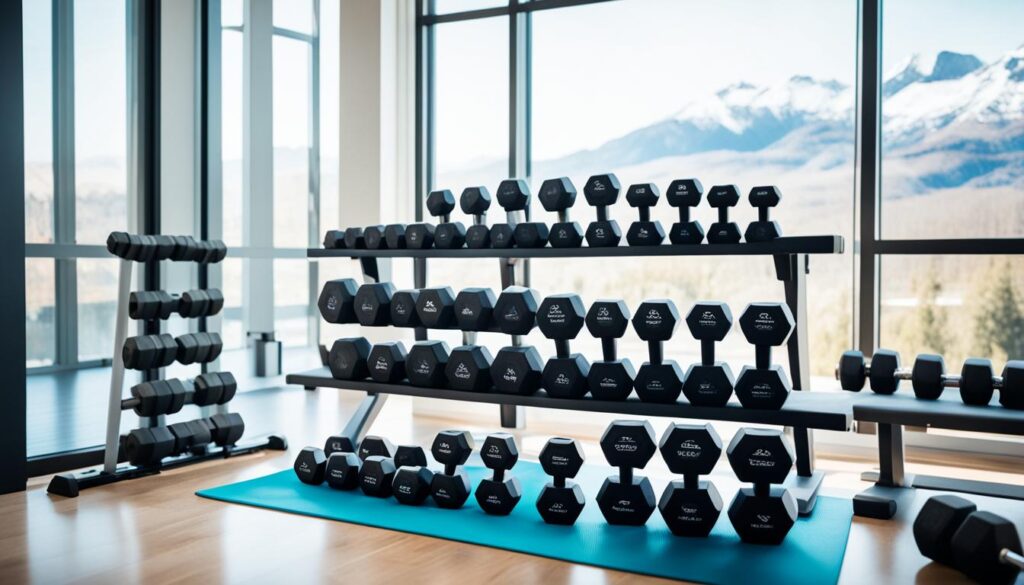
Invest smart to keep quality high without spending a lot. Bells of Steel offers durable products at lower prices when you buy more together. For a full setup, consider their residential power rack at $449. Pair it with Bells of Steel interlocking rubber flooring mats at $35 each. This combination makes your gym safe and stays within budget.
| Item | Price | Weight Capacity | Special Features |
|---|---|---|---|
| Titan Fitness T-2 Series Rack | $400 | 2,200 lbs | Stability and strength |
| Iron Bull Strength Kettlebells | Varies | Up to 70 lbs | Durable cast iron, color-coded |
| Giant Lifting Adjustable Weight Bench | Budget-friendly | Not specified | 6 back adjustments, stable design |
| Bells of Steel Residential Power Rack | $449 | High | Discounts available with bundles |
| Bells of Steel Interlocking Puzzle Rubber Mat | $35 per piece | Durable | Creates safe workout environment |
Setting Up Your Workout Routine
Creating a workout routine at home is crucial. It’s important to pick workout routines at home that fit your space and are fun. Luckily, many fitness apps and online resources can help.
Finding Workouts That Fit Your Space
First, look at how much space you have. For small areas, bodyweight exercises or minimal equipment work well. HIIT routines are great because they don’t need much gear.
Exercises like push-ups and squats are good. Customizing your routine for your space helps keep you on track. Apps like Peloton and Les Mills On Demand have classes for all kinds of spaces and skill levels.
Utilizing Apps and Online Resources
Fitness apps are super helpful for setting up your workout plan. Peloton, Nike Training Club, and MyFitnessPal let you pick from many classes, track your progress, and join fitness communities. They offer:
- Many workout choices for any spot
- Videos to help with your technique
- Plans made just for you
Don’t forget about online resources like blogs and YouTube channels. They have lots of tips and advice for workout routines at home. They keep you interested and motivated.
| Fitness App | Key Features | Average Monthly Cost |
|---|---|---|
| Peloton | Live and on-demand classes, community features, various workout types | $12.99 |
| Nike Training Club | Bodyweight and equipment-based workouts, customizable plans | Free & Pro version $14.99 |
| MyFitnessPal | Calorie tracking, meal planning, supports workout log | Free & Premium version $19.99 |
Having the right tools and a custom plan can make your home workouts powerful and fun.
Tips for Creating an Apartment Home Gym
Starting a home gym in your apartment is both exciting and smart. You might face challenges like not having much room and the noise it might make. But, with some clever tips, you can make the most of your space. This makes sure your exercises stay fun and effective. Using these gym ideas in your apartment can make working out easy without giving up your comfort.
Maximizing Your Space
When space is tight, thinking upwards is smart. Think about putting up wall racks for your dumbbells or resistance bands. Folding mats are great because you can put them away, giving you back your floor space. Items like resistance bands or adjustable dumbbells are perfect. They don’t take up much room and are super useful. Check out these small gym tips:
- Incorporate stackable storage bins for smaller items.
- Use furniture, such as benches with built-in storage, to combine utility and style.
- Choose multi-purpose machines that do several exercises in one piece of equipment.
Noise Reduction Solutions
Worrying about bothering your neighbors in an apartment is common. But, there are quiet workout tools out there. Thick mats can help muffle sounds, making your workout quieter. Choosing quieter equipment, like air bikes or bikes with magnetic resistance, helps a lot. You can also try these ideas for keeping things quiet:
- Put down carpets or rugs to help block sound.
- Look for workout gear that’s designed to make less noise.
- Plan your workouts for when you’re less likely to disturb your neighbors.
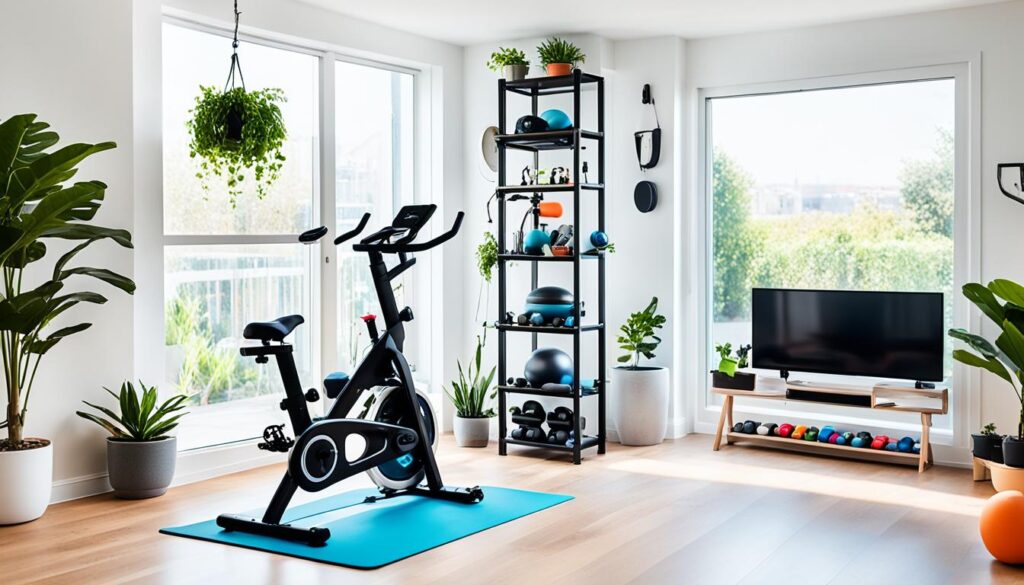
| Equipment Type | Space Requirement | Noise Level |
|---|---|---|
| Adjustable Dumbbells | Minimal | Low |
| Resistance Bands | Minimal | Silent |
| Yoga Mat | Small | Silent |
| Stationary Bike | Moderate | Moderate |
| Treadmill | Moderate | High |
To make a great gym in your apartment, think about the best fitness solutions and saving space. Choosing the right gear and managing noise will make your workouts enjoyable. You can have an amazing workout space in any apartment.
Cost Breakdown of Home Gym Setups
Understanding the costs of setting up a home gym helps you decide wisely. This guide covers different price ranges for setting up a budget-friendly gym. It shows what equipment you can get at each price level.
Home Gym Under $100
You can set up a simple workout area for less than $100. Here’s what you can buy without spending much:
- Resistance bands: $10 – $30
- Jump rope: $10 – $20
- Exercise mat: $20 – $50
- Lightweight kettlebells: $25 – $40
Home Gym Under $500
A budget of $500 brings more options for equipment. It’s great for building a better workout space:
- Dumbbells: $25 – $400
- Kettlebells: $25 – $400
- Adjustable weight bench: $100 – $300
- Medicine ball: $30 – $150
Home Gym Under $1500
With $1500, you can add versatile workout machines. These machines provide a full-body workout:
- Treadmill: $400 – $1,500
- Rowing machine: $600 – $1,200
- Elliptical: $300 – $2,000
- Indoor bike: $300 – $2,500
Investing in a complete home gym has lasting benefits. The cost, around $2,000 on average, can save money compared to gym memberships. The average gym membership costs about $31 to $44 per month. Having your gym at home not only meets fitness goals but also saves money in the long run.
| Budget Tier | Equipment Examples | Estimated Cost |
|---|---|---|
| Under $100 | Resistance bands, Jump rope, Exercise mat | $10 – $50 each |
| Under $500 | Dumbbells, Kettlebells, Adjustable weight bench | $25 – $300 each |
| Under $1500 | Treadmill, Rowing machine, Indoor bike | $300 – $2,500 each |
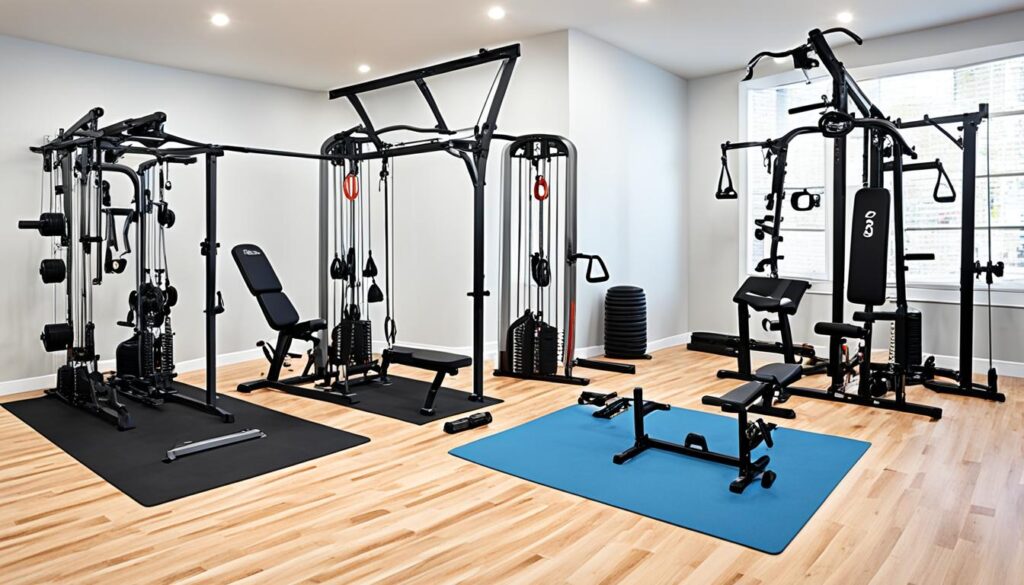
Maintaining Motivation in Your Home Gym
Getting motivated for home workouts can be tough. It’s crucial to set up a workout schedule at home. Doing this converts sporadic fitness attempts into a daily habit.
Establishing a Workout Schedule
Building a structured workout plan boosts steadiness. It matters whether you assign days for varied exercises or work out at the same time daily. A well-thought-out plan is key for steady gym motivation. Tips to keep in mind include:
- Create a weekly plan that includes diverse workouts, such as strength training, cardio, and flexibility sessions.
- Set achievable goals that align with personal fitness aspirations to foster a sense of accomplishment.
- Use reminders or apps to keep track of workout days and times.
Creating an Inspiring Workout Environment
The vibe of your home gym atmosphere matters a lot. A nicely set-up space boosts your mindset. To improve your workout space, consider these suggestions:
- Incorporate good lighting that creates an inviting ambiance.
- Add mirrors to help in monitoring form and technique during workouts.
- Keep the space tidy and organized to minimize distractions and promote a focused mind.
- Include motivational quotes or art to inspire during workouts.
Adding a personal touch can really make your gym spot more inviting. Plus, with a good space and plan, getting fit becomes fun.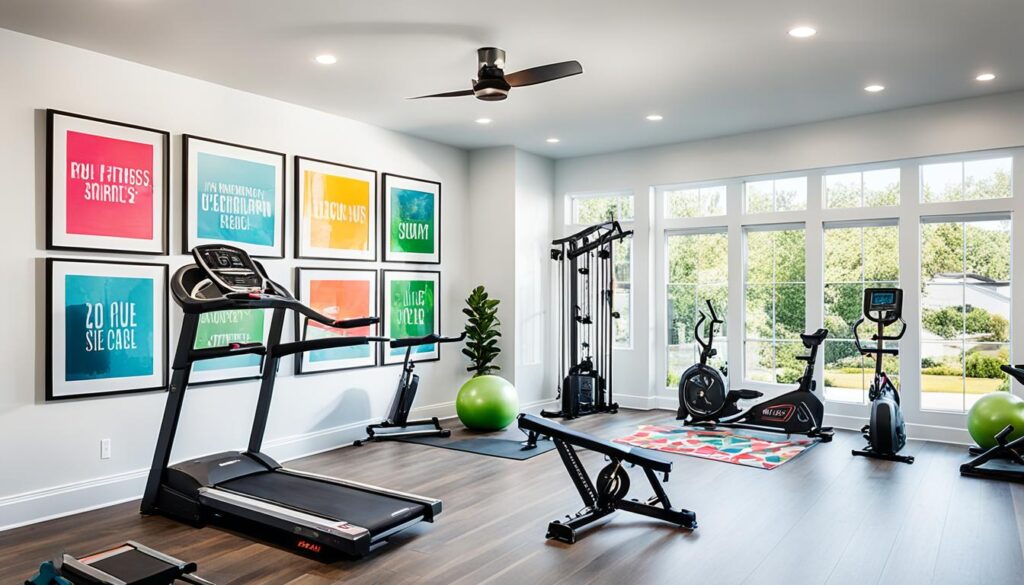
Conclusion
Creating a fitness space at home has many benefits. It improves your health and wellbeing. At home, there’s no pressure like at local gyms, so you can work out in peace. You can make a gym that fits your exact needs and likes, even if you’re on a budget.
Starting small with your home gym is okay. You might begin with basic items like a yoga mat, dumbbells, and some cardio machines. Over time, you can add things to make your workouts better. For organization, consider adding shelves or baskets. This keeps your space tidy and makes exercising more fun.
Reaching your fitness goals doesn’t have to cost a lot. With small steps and a personalized setup, you can enjoy working out at home. Starting this journey means investing in your wellbeing. In the end, this effort pays off and leads to a healthier life.FAQ
What are the main benefits of setting up a home gym?
What essential equipment do I need for a well-rounded home gym?
How can I budget effectively for my home gym setup?
What should I consider when creating a workout space at home?
Where can I find affordable gym equipment?
How can I structure my workout routine at home?
What are some tips for setting up a home gym in an apartment?
Can you provide examples of budget ranges for home gym setups?
How can I stay motivated while working out at home?
Lifestyle
Mindful Living: Incorporating Zen Principles into Your Home Design
Transform your space into a serene oasis with Mindful Living: Incorporating Zen Principles into Your Home Design for tranquility and balance.
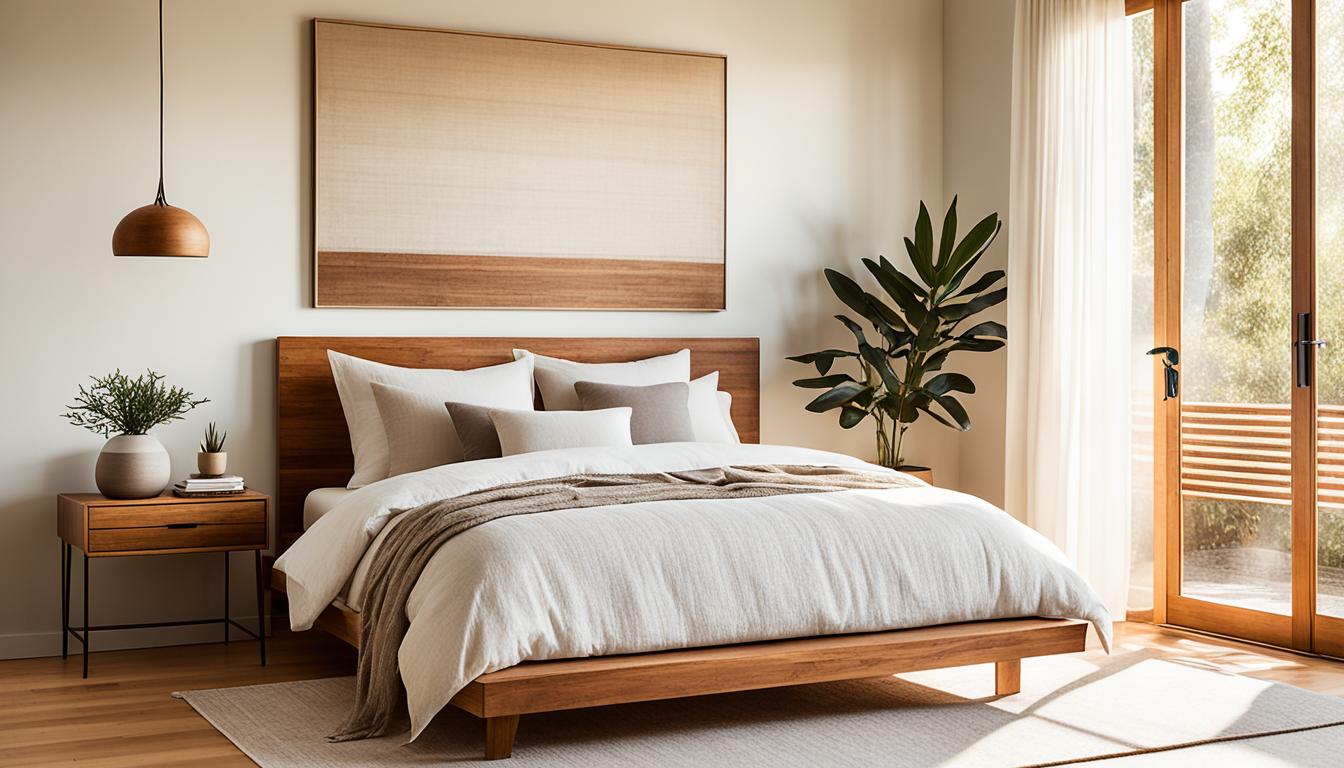
While maneuvering through their disorganized living room, they were consumed by a sense of disorder. Concentration and peace were hard to come by. However, upon stumbling upon an article about Zen in home design, they became inspired. They made the decision to turn their space into a peaceful sanctuary.
In their journey, they chose natural textures and neutral colors. They picked furniture that was both simple and comfy. Their once unclear surroundings became a peaceful refuge, reflecting Zen’s calm and balance. This transformation turned their home into a place that boosted mental clarity and well-being.
Creating a Zen environment goes beyond looks; it’s a meaningful way to live more mindfully. Next, we’ll dig into how a home can harmonize with life and deeply affect our daily living.
Key Takeaways
- Zen-inspired home design promotes tranquility and mindfulness.
- Natural elements like bamboo and wood enhance emotional well-being.
- A minimalist approach in decor reduces stress and creates serenity.
- Indoor plants improve air quality and enhance the aesthetic of the space.
- Natural light plays a vital role in uplifting mood and well-being.
Understanding Zen Interior Design Principles
Zen interior design is all about simplicity and tranquility. It takes inspiration from Zen Buddhism. This style aims to create spaces that bring about harmony and a peaceful mindset. It focuses on decluttering, using soothing colors, and adding natural elements. This way, Zen Design makes a home feel calm and clear.
Defining Zen Design
Zen Design is about creating serene living spaces. It is deeply rooted in Japanese traditions and favors minimalism. The idea is to avoid too much decoration and choose pieces that have meaning. Materials like wood, stone, and bamboo are key. They help to connect the inside of a home with the natural world.
Key Elements of Harmony and Balance
Let’s look at what makes Zen Design work:
- Open spaces: These promote emotional well-being and clear thinking.
- Neutral color palettes: Gentle colors like beige and light gray add to the calm.
- Functional furniture: Choose pieces that are practical yet simple.
- Natural light: Sunlight can make any room feel more peaceful.
- Mindful decor: Pick items that make you happy and add to the tranquility.
Combining these elements can create a space that mirrors your inner peace. Adopting Zen principles in your home can lead to less stress, better focus, and a stronger bond with nature.
https://www.youtube.com/watch?v=YoL9WSwznhg
| Key Element | Description | Impact on Space |
|---|---|---|
| Open Spaces | Encourages flow and emotional clarity. | Promotes relaxation and focus. |
| Natural Materials | Incorporates elements like wood and stone. | Bridges the gap between indoors and outdoors. |
| Neutral Colors | Employs soft tones for a calming effect. | Enhances mental clarity and tranquility. |
| Minimalism | Utilizes fewer, well-chosen pieces. | Eliminates clutter, resulting in peace of mind. |
| Nurturing Decor | Focuses on items that bring joy. | Fosters a positive atmosphere in the space. |
The Benefits of a Zen-inspired Home
A Zen-inspired home makes life better and more peaceful. It uses simplicity, harmony, and balance. This approach improves various aspects of life.
Improved Mental Clarity
One big plus of Zen design is better mental clarity. Minimalist spaces help focus and boost creativity. Less clutter means you feel more organized and calm.
Reduced Stress and Anxiety
A Zen home can cut down on stress. Neutral colors and simple furniture bring calm. This peaceful spot helps manage stress better day by day.
Enhanced Connection to Nature
Linking to nature is key in Zen design. Adding plants and using natural materials like bamboo enrich the space. It makes you appreciate nature more and boosts happiness.
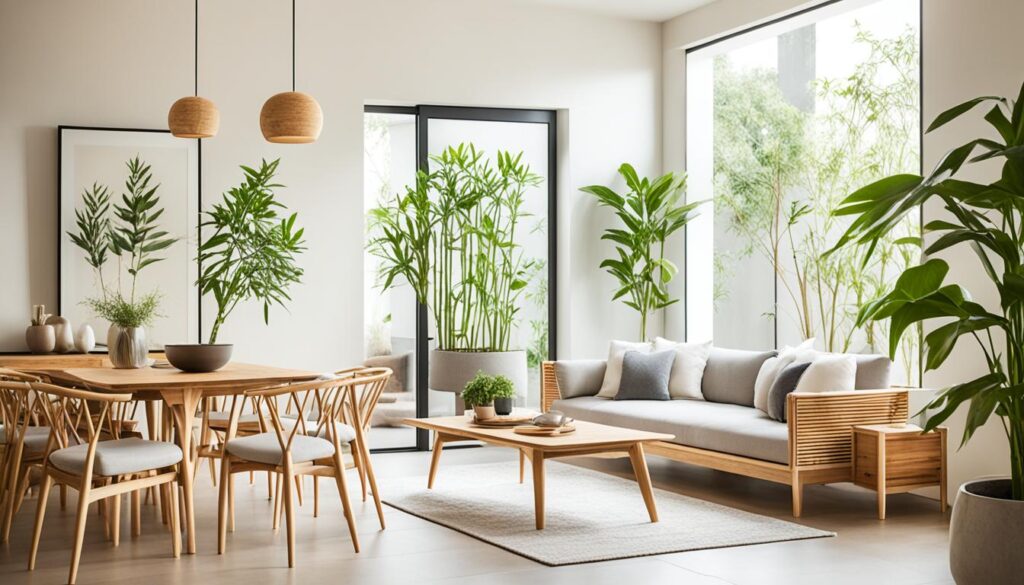
Achieving Balance through Colors
Color is key in making a Zen home feel calm and balanced. Choosing the right colors helps create a peaceful space. This promotes mental clarity and relaxation.
Neutral Color Palettes
Neutral colors are key for a calm environment. Think soft whites, light grays, and warm beiges. They make for a serene backdrop. These colors keep the balance Color Balance and let other design pieces shine without being too much.
Earthy Tones and Natural Textures
Earthy tones add depth and connect us to nature. Terracotta, muted greens, and sandy browns are perfect. Pair these with natural materials like wood, bamboo, and rattan. It creates a warm and inviting space, adding to the beauty of the room.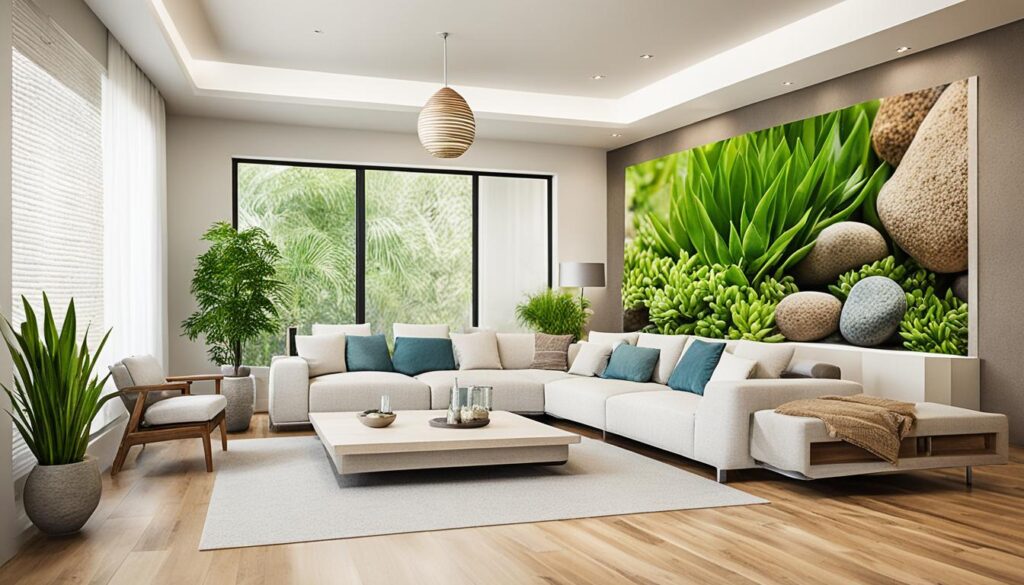
Simplistic and Functional Furniture
Choosing the right furniture is key to making a space calm and balanced. It’s about mixing simple looks with comfort. This leads to furniture that not only looks good but is useful too. These kinds of pieces are core to Zen living. They make any space more welcoming.
Minimalist Aesthetics
Minimalist style means clean lines and clear surfaces. This clean approach helps create a peaceful place. It lets people focus on what’s important. Furniture that’s simple helps make a place peaceful. Using natural materials like wood and linen adds warmth. They blend well with the room.
Comfort and Practicality
Looks are key, but comfort is also a must. Functional furniture should look good and be useful. It keeps the room usable and cozy. Choosing items like ottomans that also offer storage helps use space well. This keeps the clutter down. With the right furniture, your home becomes a haven.
| Furniture Type | Features | Aesthetic Appeal | Comfort Level |
|---|---|---|---|
| Wooden Sofa | Natural materials, clean lines | Warm and inviting | High |
| Modular Shelving | Flexible configuration, multi-functional | Stylish and unobtrusive | Medium |
| Minimalist Coffee Table | Simple design, ample surface area | Chic and modern | High |
| Storage Ottomans | Dual purpose: seating and storage | Versatile and sleek | High |
| Neutral-toned Recliners | Comfortable, ergonomic design | Elegant and understated | Very High |
Incorporating Natural Elements
Embracing natural elements is key for a peaceful home. Indoor plants and water features make spaces look and feel tranquil. They connect us to nature, crucial for Zen design.
Indoor Plants and Water Features
Indoor plants are at the heart of Zen spaces. Bamboo and peace lilies clean the air and soothe the mind. Adding water features, like small fountains or aquariums, brings relaxing sounds. Plants and water together build a peaceful place, meeting the desires of many seeking calm at home.
Organic Materials and Fabrics
Using organic materials adds beauty and supports eco-friendly living. Cotton and reclaimed wood give a natural, cozy feel. Neutral colors are popular for their calming effect and blending with nature. This aligns with the 65% who like Zen-inspired decor.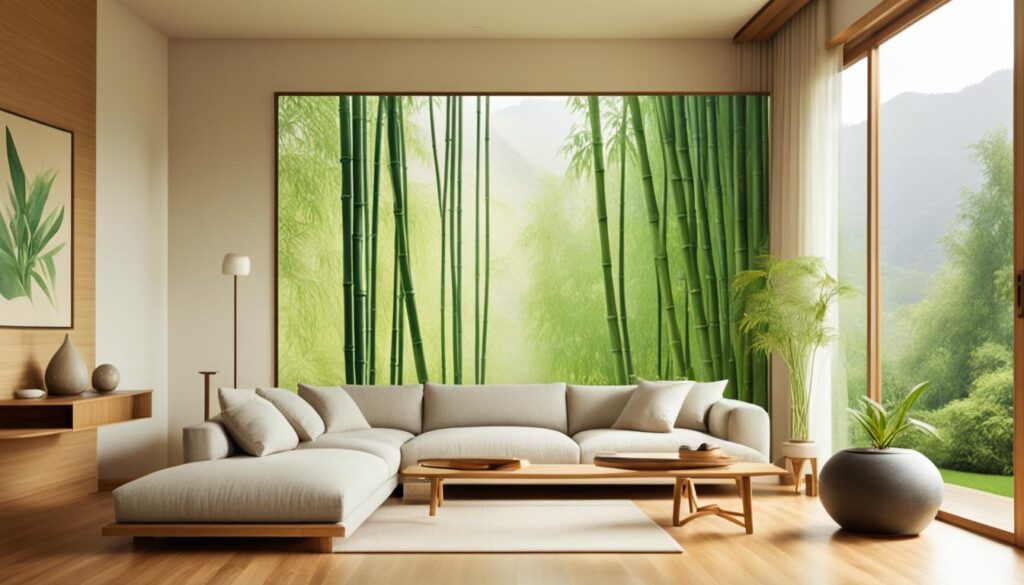
The Importance of Lighting in Zen Design
Creating the perfect atmosphere in Zen spaces is all about the right Lighting in Zen Design. The right lights can change the energy and warmth of a space, making it more peaceful and mindful. Using natural light is key. It connects us to the outside world and makes the area calm. Adding special lighting features brings peace to the whole home.
Maximizing Natural Light
Natural light is crucial in Zen design. It affects how we feel and our comfort. When a room is lit naturally, it highlights neutral and earth tones. This creates a calm and relaxed atmosphere. It also helps with clarity and mindfulness, which are important in Zen living. Here are ways to bring in more natural light:
- Use big windows or sliding glass doors.
- Add skylights for more sunlight.
- Place mirrors to reflect and spread natural light.
Creating a Soft and Warm Ambiance
Apart from natural light, soft artificial lighting is vital in Lighting in Zen Design. It removes harsh shadows and makes a space welcoming. Use lights that give off a warm glow, like:
| Type of Fixture | Light Source | Effect |
|---|---|---|
| Floor Lamps | LED bulbs | Directs soft light into corners, enhancing warmth |
| Table Lamps | Incandescent bulbs | Adds cozy light for reading and relaxation |
| Wall Sconces | Soft white bulbs | Provides ambient lighting without glare |
Mixing these lighting types creates a peaceful vibe. It makes people feel good. Focusing on soft lights in a Zen living room is key for a relaxing environment.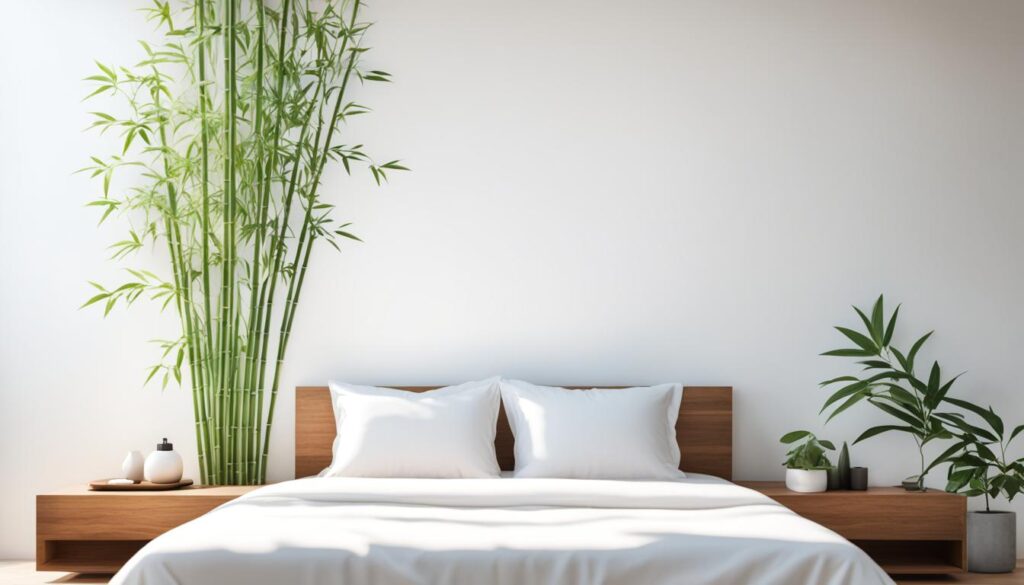
Mindful Living: Incorporating Zen Principles into Your Home Design
Creating a home with Zen principles means thoughtful design and Mindful Organization. It’s about making Relaxation Spaces for peace and mental clarity. By cutting down clutter and designing areas for relaxation, we can live better and more mindfully every day.
Strategies for Mindful Organization
Starting by decluttering is key to a peaceful home. Studies show cluttered spaces raise stress levels by 30%. A neat home not only looks good but also promotes calmness. Below are strategies for Mindful Organization:
- Remove unnecessary items that do not serve a purpose.
- Utilize storage solutions that keep possessions neatly tucked away.
- Adopt a “one in, one out” rule for managing incoming items.
Designating Spaces for Relaxation
It’s crucial to have dedicated Relaxation Spaces for mental health. These spots should be calming, ideal for meditation or relaxation. Soft, diffused lighting, for example, can lower anxiety by 20%. Think about these tips for your Relaxation Spaces:
- Set up a reading nook with comfortable seating and natural light.
- Integrate indoor plants to boost air quality by 25%.
- Add water features for their soothing sounds, which can lower heart rates by 10-15%.
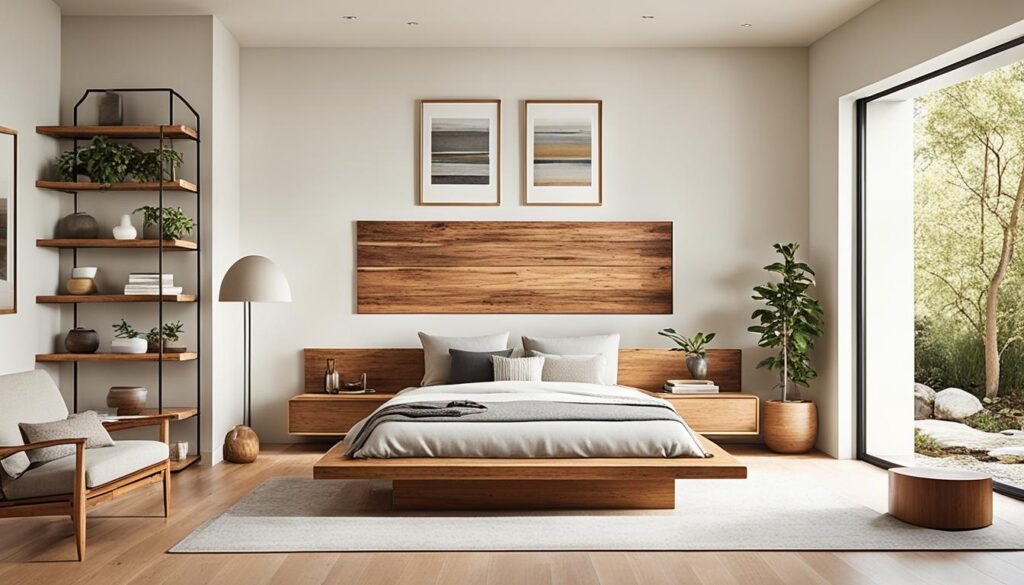
Focusing on mindful home design helps nurture mindfulness, drop stress, and foster peace of mind.
Creating Zen Nooks in Your Home
Zen nooks are peaceful spots that bring quiet and focus to your day. Choosing the right setup is key to making these areas soothing. By picking comfy seats, lovely decor, and bits of nature, you create a special corner for thinking and chilling out.
Purposeful Arrangement of Zen Nooks
When making Zen nooks, go for simple and comfy vibes. Use calm colors like white and light beige to make the area relaxing. Adding elements like wood, stone, and bamboo ties the space to nature. Also, adding green plants such as peace lilies and bonsai trees makes the space prettier, cleans the air, and helps you relax.
Encouraging Mindfulness in Everyday Spaces
Soft lighting really changes how mindfulness areas feel. Using table lamps and wall sconces brings a gentle light that helps calm the mind. Plus, adding scents like lavender or sandalwood with essential oils makes the space even more soothing. Decorating with meaningful items can make the area special and encourage mindfulness.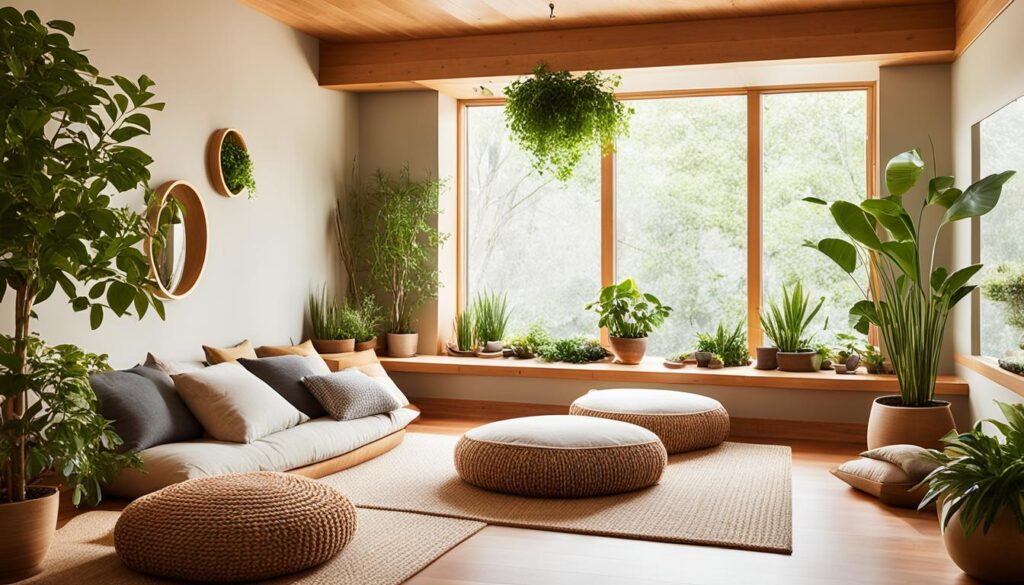
Keeping Zen nooks tidy and well-organized is crucial. Hidden storage helps keep things out of sight. Putting down rugs made of natural fibers adds coziness and is easy to clean. Using walls for shelves or bookcases helps avoid clutter without sacrificing space. All these elements together create an inviting space that promotes mindfulness.
Transforming Your Space with Water Elements
Water Elements are key to a peaceful setting. They follow Zen design rules. Adding water features at home boosts its look and feel. It also brings calmness and peace. The sound of water flowing makes any Zen space perfect.
Benefits of Water Features
Water features do many things. They can:
- Introduce a calming ambiance, transforming the atmosphere of a room.
- Act as natural sound barriers, diminishing unwanted external noise.
- Enhance the visual spatial dynamics, creating a focal point for meditation.
Features like indoor fountains or ponds add a calm vibe. They help highlight nature, a big part of Zen philosophy.
Implementing Tranquil Water Sounds
Add Tranquil Water Sounds to feel more peace and focus. The soft water noise helps with stress and practicing mindfulness. To do this, you can:
- Strategically placing fountains or water bowls in quiet corners.
- Utilizing apps or speakers to play nature sounds like rain or streams.
- Creating a small indoor waterfall to provide continuous, gentle audio.
These sounds boost concentration during meditation. They make the peaceful feeling of water elements even stronger.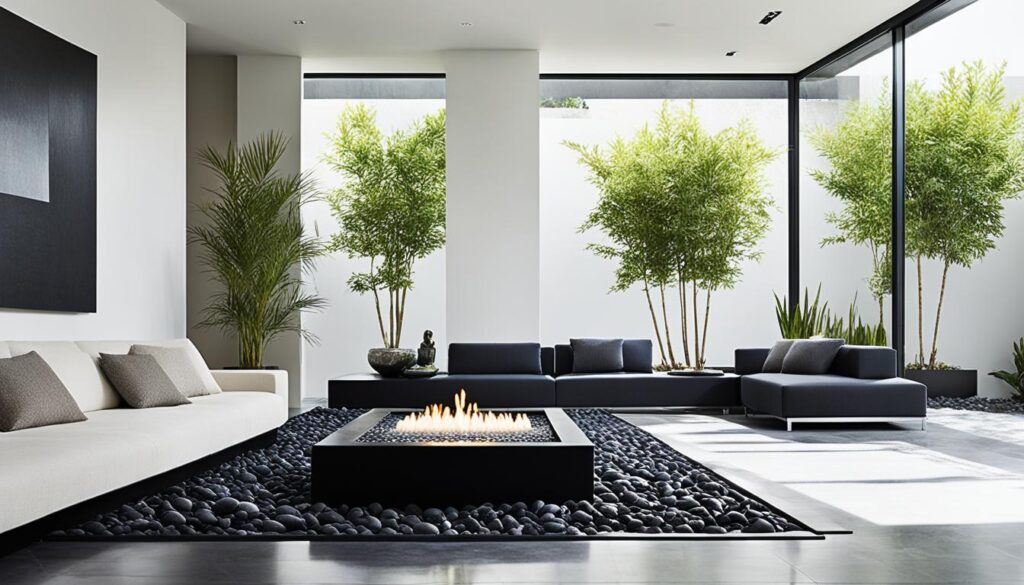
Integrating Sound and Aroma for Mindfulness
Creating a peaceful home space can greatly improve mindfulness. By mixing Sound for Mindfulness with aromatherapy, one can create a calm and relaxing atmosphere. This combination helps elevate the mindfulness experience in everyday life.
Using Sound for Serenity
Soft music and sounds like water flowing or birds chirping help create peace. Studies show music can lower anxiety and help with stress. These soothing sounds make meditation spots or quiet corners more calming.
Aromatherapy and Natural Scents
Scents like lavender, chamomile, and jasmine from essential oils boost this calming environment. Aromatherapy complements mindfulness by promoting calm and balance. To keep the air healthy, use natural scents in things like diffusers or candles. Combining both Sound for Mindfulness and scents offers a full approach to better relaxation and mindfulness.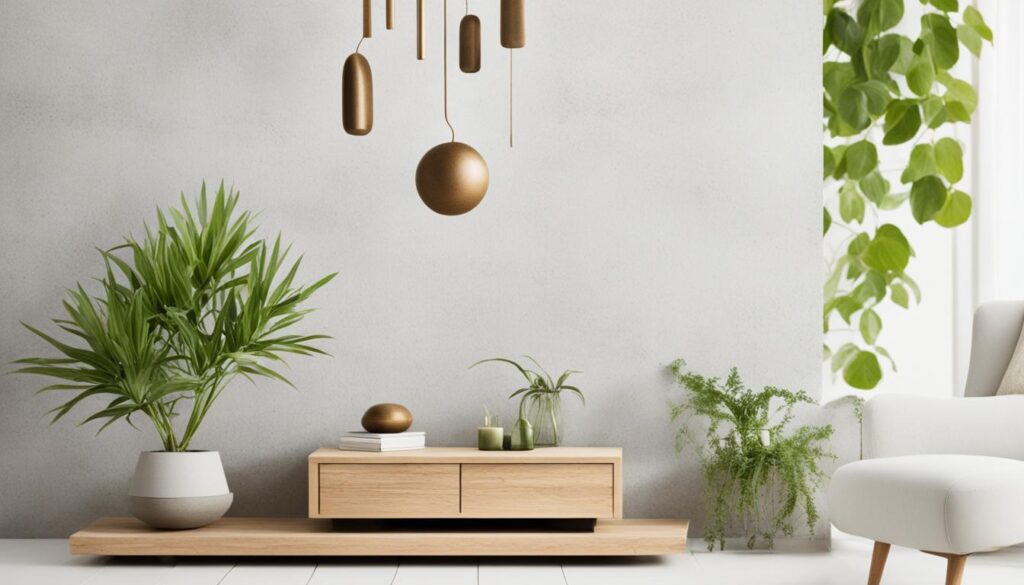
Conclusion
Zen home design is more than just a trend. It’s a way to truly live mindfully. In 2024, the idea of Zen Dens is becoming more popular. People see the value in making peaceful spots at home that help mental and emotional health. Adding nature, calming colors, and simple furniture turns homes into quiet places for rest and thought.
Zen Dens are key for getting away from today’s busy world. They stand for simplicity and balance. With plants, soft lights, and calm sounds, they’re perfect for meditation and being mindful. They offer a retreat from stress and being online too much. Setting up these spaces right is important for a balanced life.
In a busy world, choosing Zen design helps make homes that are good for body, mind, and soul. Living mindfully means everyone can have a peaceful spot that brings clear thinking, harmony, and closeness to nature. It’s worth thinking about how Zen can make homes into places full of peace and happiness.FAQ
What are the core principles of Zen interior design?
How can a Zen-inspired home improve mental well-being?
What role do colors play in achieving a Zen atmosphere?
Why is furniture selection important in Zen design?
What are some natural elements to include in a Zen home?
How does lighting impact a Zen space?
What strategies can help with mindful organization at home?
What are Zen nooks, and how can they be created?
How do water features contribute to a Zen-inspired environment?
How can sound and aroma be integrated for mindful living?
-

 News3 weeks ago
News3 weeks agoYoung Tennis Prodigy Emerges: Merri Kelly Hannity
-

 Lifestyle3 weeks ago
Lifestyle3 weeks agoSocial Growth: How to Grow Your Home Decor Instagram Following!
-
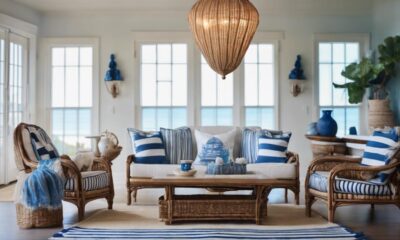
 Vetted1 month ago
Vetted1 month ago15 Best Coastal Home Decor Items to Transform Your Space Into a Seaside Oasis
-

 Vetted1 month ago
Vetted1 month ago15 Best Home Decor Dupes That Look Expensive But Are Budget-Friendly
-

 Lifestyle1 month ago
Lifestyle1 month agoShow Your Love: How to Appreciate Someone's Home Decor in 5 Easy Steps!
-

 News3 weeks ago
News3 weeks agoJ.D. Vance: No Couch Affair, Still Extremely Weird
-
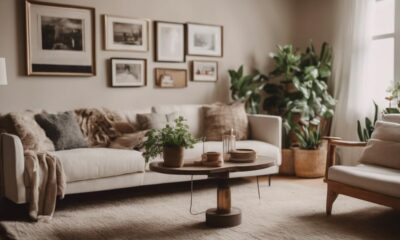
 Lifestyle1 month ago
Lifestyle1 month agoUltimate Guide: How to Arrange Home Decor for a Stunning Look!
-

 News3 weeks ago
News3 weeks agoGlobal Impact: CrowdStrike Outage Hits Microsoft Systems



